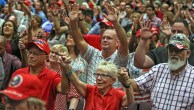Pew Forum Faith Angle Conference Key West, Florida

Some of the nation’s leading journalists gathered in Key West, Fla., in December 2007 for the Pew Forum’s biannual Faith Angle Conference on religion, politics and public life.
John Green, author of The Faith Factor: How Religion Influences American Elections, described how George Bush’s victory in 2004 may have hinged on his ability to win votes from mainline Protestants and Roman Catholics. Members of these two groups are “on the move” politically, however, said Green, and a candidate with the right message could win them over in 2008.
More from the December 2007 Faith Angle Conference
Religion and Secularism: The American Experience
Religious Literacy: What Every American Should Know
More: Research, news, blogs
Analyzing recent surveys, Green suggested that the line dividing more observant and less observant voters – so pronounced in the 2004 election – may be blurring. Finally, Green pointed out that while a majority of Americans both like the idea of a president with strong religious faith and enjoy hearing candidates talk about their beliefs, a significant minority are turned off by what they perceive as too much faith talk; candidates must therefore walk a fine line in order to satisfy both constituencies.
Speaker:
John C. Green, Senior Fellow in Religion and American Politics, Pew Forum on Religion & Public Life
Respondents:
Michael Barone, Senior Writer, U.S. News & World Report
E.J. Dionne Jr., Senior Fellow, The Brookings Institution; Columnist, The Washington Post; Senior Advisor, Pew Forum on Religion & Public Life
Moderator:
Michael Cromartie, Vice President, Ethics & Public Policy Center; Senior Advisor, Pew Forum on Religion & Public Life
Navigate this Transcript John Green’s opening remarks Michael Barone’s response E.J. Dionne’s response Q&A with journalists
Editor’s note: The tables to which John Green refers are embedded in the transcript below. You can also download and print a PDF of the tables.
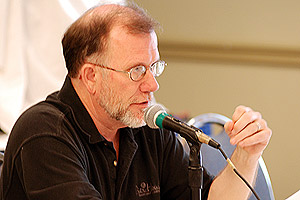
[today]
John, thank you for coming.

JOHN GREEN: Thank you, Michael, for having me back. It’s a great privilege to be here again, and it’s wonderful to be with all of you. I’ve known most of you in previous incarnations, but it’s great to have a chance to meet some new people, and, not only that, to put faces to the names and to the voices on the telephone. Some of you even have very characteristic e-mail styles. It is a special joy to share this panel with Michael Barone and E.J. Dionne, who, as you all know, are two of the most insightful observers of religion in American politics.
What I’d like to do today is look at some survey data because that’s what I do. What I’d like to do is work through a number of tables, which I think reveal some interesting things about the role of faith in the upcoming presidential election. We have decided to overwhelm you with paper this morning, and so you will see in front of you all kinds of reports. We’ll mention them, but what I’d like to turn your attention to is to this one right here, which is a collection of tables that are stapled together, and they begin with Table 1, “Religious Groups in the 2004 Presidential Vote.” We’ll work our way through these tables.
I made these tables so I take full credit for all of their mistakes. One of the mistakes I made is that I stapled them all together, so you might want to pull them apart because we’ll want to compare them. Unfortunately Table 1 and Table 2 are on the reverse sides of the same page, which is why I worry about voting behavior and not about making tables.
There are three things I’d like to discuss this morning. The first is how the structure of religion and politics works in American elections these days, and whether or not it may persist into the 2008 election. Secondly, I’d like to look at a couple of the influences that might have an effect on the structure of religion’s impact on the vote, particularly people’s attitudes toward religious expression in political campaigns, and, then, the issue priorities of the different religious groups. Finally I’d like to make a few general comments about religious groups in the primaries. The great bulk of my comments will be about the general election, but of course people have to get nominated before we can have a general election, and religion may play a role there as well, but a different kind of role.
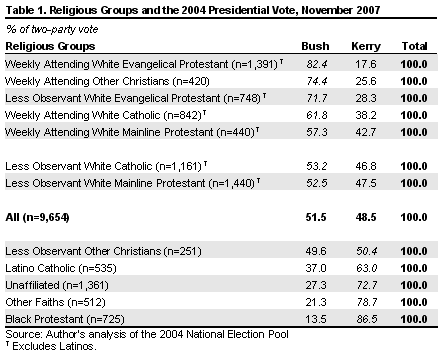
So if I could turn your attention to Table 1, the very first table. This is a list of religious groups and how they voted in the 2004 presidential election. It reports the two-party vote, and this comes from the 2004 national exit polls. The point of this table is to set a baseline for our discussion by noting what happened in the last election. If you look in the middle of the chart – all our charts will be structured this way – there’s a column called “All,” and that reflects the numbers for the entire sample, or, in this case, the entire electorate, that is all the people who voted in 2004. As you can see, Bush won the election by a very small margin.
These religious groups are arrayed according to the two-party vote. Above the “All” column, toward the top of the page, we have the groups that voted more for George Bush. Then toward the bottom of the table we have groups that voted more for John Kerry. Just a very quick glance at the table will reveal three groups. The Republicans have strong religious constituencies. The Democrats have strong religious constituencies, and there are some groups in the middle. In 2004 Bush won those groups in the middle, at least the ones we’re going to look at here today.
But let me just spend a moment talking about these religious categories. They are a little different than the ones you sometimes see from me or the Pew Forum. It is the same data; it’s just arranged in a different way. The reason is so we can look across surveys. Not all surveys have exactly the same number of religious categories, and we quickly reach a point where certain small religious groups become statistically insignificant in one or another of the surveys. We want to work with categories that have a “minimum significance” in as many tables as possible.
Up at the very top of the table we have the group that everyone talks about, sometimes referred to as the “religious right.” At the core of that group are weekly attending white evangelical Protestants. In these surveys, evangelicals are defined as born-again Protestants. Here we separate out whites and people who tell us they attend worship once a week or more often.
One of the important elements of the faith factor these days is religious affiliation, and most of these groups are defined by affiliation. Race and ethnicity are very closely connected to religious affiliation, so they’re part of the definition for many of these groups. But there’s another element present and that is religiosity, and in these surveys we measure that with worship attendance. That’s not the only way, or maybe even the best way to measure religiosity, but it’s a very common and effective way.
So if you look at the very top group, weekly attending white evangelicals, notice that 82.4% of them said they voted for President Bush in 2004. But if you go down just two lines to less-observant white evangelical Protestants – these are white born-again Protestants who claim not to attend church once a week or more often – notice they also voted for Bush, but by a good bit less, in fact, about 11 percentage points less. So there you see both the effects of affiliation and religiosity: Being a white evangelical Protestant moves one in a Republican direction, but being a regular worship attender moves one further along in a Republican direction.
If you go a little farther down, one of the next groups is weekly attending non-Latino Catholics. These are basically white Catholics, but we did include Asians and African-Americans, who are a very small portion of that community. Notice that they voted a little more than three-fifths for Bush. But if we go down just a little bit farther we come to less-observant white Catholics, who Bush won by a small margin, just 53% of the vote. There again, you see the attendance gap.
Another religious group are white mainline Protestants. This group isn’t defined very well in these surveys, but they are very distinctive nonetheless. These are white non-born-again Protestants, and you can also see differences by attendance in those groups.
[also]
But notice even among these “Other Christians,” there’s a big attendance effect. Those who report attending regularly were much more for Bush than those who were not. Down toward the bottom of the table there are some other groups: the unaffiliated, people who don’t have a religious affiliation; the other faiths, that’s also a combination of different groups, mostly non-Christian groups, including Jews, Muslims, Hindus, Buddhists, Wiccans, and other sorts of groups, which again we combined – normally we would break them out, but today for pragmatic purposes we have to put them together. Then of course we have black Protestants, that is, members of historically black Protestant churches.
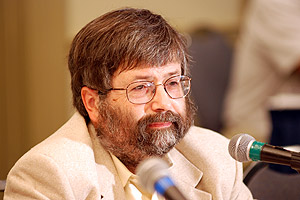
As you can see, there was quite a bit of polarization in 2004, based upon these religious categories of affiliation and attendance, with Bush doing very well with some groups, Kerry doing very well with others, and some groups in the middle, including less-observant white Catholics and less-observant mainline Protestants, which were very much up for grabs all throughout the campaign, and Bush ended up winning them by a small margin. In places like Ohio that might very well have made the difference. In any event, Table 1 shows what happened in 2004, and we can see the structure of religion when it comes to the vote, with both affiliation and attendance mattering in important ways.
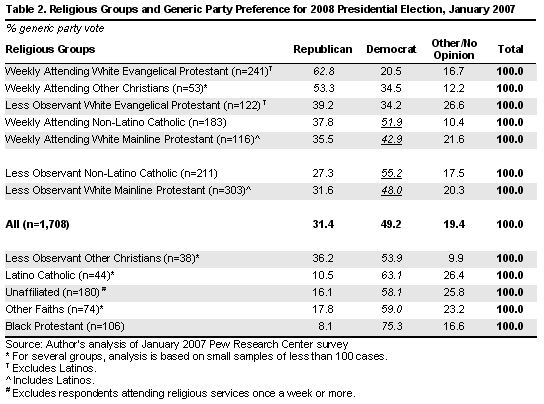
Let’s turn to Table 2. Table 2 comes from a survey that was taken in January of 2007, just about a year ago, by the Pew Research Center. The survey asked people about their generic party preferences. Would they be more likely to vote for a Republican candidate for president in 2008 or for a Democratic candidate? Now there are no candidates in this question, it is just a party preference. Two things immediately become clear. One is that the Republicans don’t do nearly as well in this survey as George Bush did in 2004, and there is a very striking diminution of support for a generic Republican candidate. Some respondents are in the “No Opinion” column because not everyone had made up their mind about the 2008 election.
Let me call your attention to a couple of things. First of all, look at the “All” column in the middle of Table 2. Look at the Democratic vote. In this survey 49.2% of the respondents said they wanted to vote for a Democratic candidate. Now just compare that back to the actual vote that John Kerry got, according to the exit polls in 2004. It was 48.5%. Statistically, those are the same numbers. So the Democratic vote doesn’t vary very much in aggregate between these two data points: one, the actual vote in 2004, and two, this generic party ballot in 2007.
The change is really on the Republican side, which is what you might expect because the Republicans, after all, won in 2004, and then they had a lot of bad luck afterwards, perhaps some of it of their own making. Of course this 2007 poll in January comes after their big defeat in the 2006 congressional elections, so maybe it’s not surprising that we would see this diminution in generic backing for the GOP.
The second thing to notice, though, is that by and large the structure of the religious vote is the same. The groups that tended to support Bush in 2004 still support the Republicans in general, even though their numbers are down, and we still see a difference based on attendance. Again, a good example would be to look at the weekly attending evangelical Protestants at the top of the table, still more than 60 percent for a generic Republican candidate. But notice that the less-observant evangelical Protestants are down at less than 40 percent, a 20-point gap – that’s a larger gap than we saw in the exit poll data.
So the basic structure of the faith factor on the vote seems to be in place, although the numbers have shifted. It’s entirely possible for a Democratic candidate to win the 2008 election, even if the structure of affiliation and attendance is still in place. Because what matters is not just the structure, but how the structure actually functions. If Democrats do better in some of these key groups, they can win the election.
If you look in the Democratic column, you’ll see certain numbers that are underlined, three of them toward the middle. These are groups that actually switched sides between the 2004 exit poll data and these data from January 2007. Two of these groups are less-observant Catholics and less-observant mainline Protestants, those swing voters that Bush was able to win by a small margin in 2004. But also look at weekly attending Catholics and weekly attending mainline Protestants; there is also a shift into the Democratic column as well.
Although Table 2 offers a generic measure of the vote without candidates and months ahead of the 2008 election, it suggests there are some religious groups in motion, and some groups that may depart from their voting behavior in 2004.
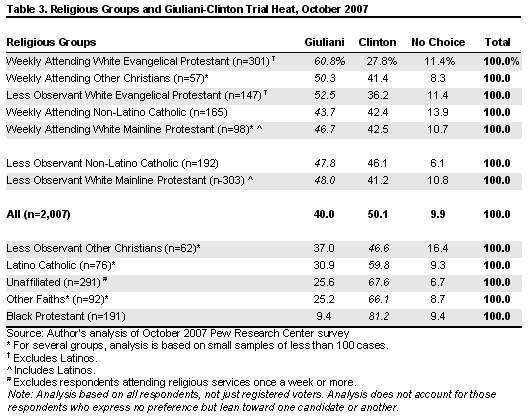
Let’s turn to Table 3, which is another snapshot of presidential preferences. It is an October 2007 trial heat in which Rudy Giuliani is pitted against Hillary Clinton from another Pew Research Center survey. I’m not, by the way, suggesting with this table that Rudy Giuliani and Hillary Clinton will necessarily be the nominees of their parties, but they were the best-known candidates in October, and therefore the easiest to get a good read on in terms of the way these religious groups may be voting.

Again, look at the “All” category in the middle. In this survey Hillary Clinton is ahead at 50%. Not a whole lot different from the Democratic vote in the generic measure in Table 2, or in the exit poll data in Table 1. Again, most of the variation across these tables is among the Republican vote, not among the Democratic vote. There are some interesting things in this table. Some of the religious groups that were in motion in 2004 are on the move again. For instance, look at the less-observant Catholics. They voted for Bush in 2004. In the generic party measure in Table 2, they were moving away from the GOP, and now they’re back with a preference for Giuliani. What a difference candidates can make – we don’t actually vote for parties, we vote for individual candidates.

Video Highlight http://blip.tv/scripts/flash/showplayer.swf?enablejs=true&feedurl=http:%2F%2Fpewforum%2Eblip%2Etv%2Frss%2F&file=http:%2F%2Fblip%2Etv%2Frss%2Fflash%2F638307&showfsbutton=false&brandlink=http:%2F%2Fpewforum%2Eorg&brandname=Pew%20Forum&showguidebutton=false&showfsbutton=true&showplayerpath=http:%2F%2Fblip%2Etv%2Fscripts%2Fflash%2Fshowplayer%2Eswf Catholics in Motion (02:28) Watch more event video on the multimedia page
Now I don’t know if these numbers will hold up next year. You could find other trial heats that would show slight differences. But they do suggest less-observant Catholics are one of those groups in motion. They move around, depending on who the candidates are and presumably what the campaign is about. Another group that shows that same kind of movement back from Table 2 is less-observant mainline Protestants.
But also note the change among weekly attending Catholics and weekly attending mainline Protestants. In this poll, Rudy Giuliani recovers some of those votes. One of the things that’s interesting about these groups is that the attendance gap has vanished. There aren’t significant differences between regular attenders and the less observant. This suggests the structure of the faith factor and the vote can change as well. I’m sure many of you remember when worship attendance wasn’t an important factor in voting behavior. It has become a very important factor in recent times, but it’s possible that in next year’s election, or the election after, the faith factor will revert to an older structure, where worship attendance is not as important to the vote.
But other parts of the picture in Table 3 are very much the same as in the previous tables. The strong Democratic groups still tend to be strong Democratic groups. Weekly attending evangelical Protestants are still in the Republican corner. It’s interesting, though, if you look at the very top number for Senator Clinton: If she were to actually get 27% of the weekly attending white evangelical vote, that would be quite significant. That would be ten percentage points better than John Kerry did in 2004. But notice that, in these data, 11.4% of weekly attending evangelical Protestants haven’t made up their mind yet, and if they, of course, were to go Democratic, that could make a huge difference. Then Hillary Clinton’s numbers would be close to the kinds of numbers that Bill Clinton got among white evangelicals in 1992. So the concern that the Democratic candidates have had about appealing to evangelicals seems to have some basis in fact. But the groups that seem to be moving are mainline Protestants and Roman Catholics. That’s where the big changes seem likely to occur.
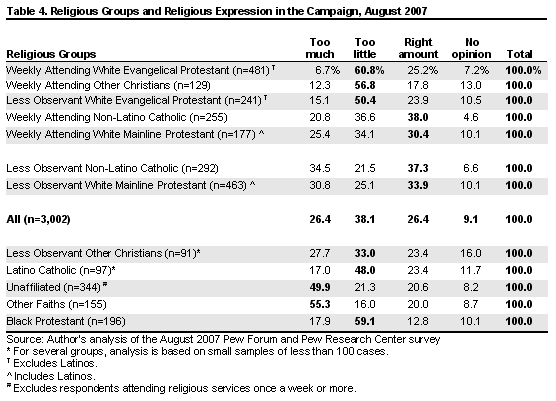
If some groups are in motion and could be moved from one party to another, this raises the question: What sorts of things motivate them? I’d like to focus on two of those things, if you will turn to Table 4. One possibility is the use of faith in election appeals, the discussions of religion by candidates, by parties, and by religious groups themselves. These data come from the annual trend survey of the Pew Forum and the Pew Research Center, taken this past summer. The question asked was: “Is there too much, too little, or about the right amount of religious expression in the campaign?”
If you look again at the “All” category in the middle, you’ll see that about a quarter of Americans say there’s too much discussion of faith. About two-fifths, though, 38.1% to be precise, say there’s too little discussion of faith in the campaign. Then another quarter say it’s about the right amount, and a few people don’t have opinions on these matters. This is interesting because I think most observers of today’s campaign would say we have an extraordinary level of religious expression in the campaign – in fact, it may set records by the time this is over next year. But a lot of Americans would like to hear even more.
Now is this because the public is just yearning to know about the spiritual and religious beliefs of candidates? Or is it because the candidates have been out there talking about their faith? It’s hard to tell, causality could go either way.
If you look at the religious groups, you can see some interesting patterns. For instance, some of those key Republican groups up at the top of the table, weekly attending evangelicals, for instance, have a majority or more that think there’s too little discussion of faith in politics and the campaign. And if you go down toward the bottom, there are some key Democratic groups, black Protestants and Latino Catholics, that have the same view. In fact, there are only a couple of groups, the other faiths, which are largely non-Christians of various kinds, and the unaffiliated who think there’s been altogether too much discussion of faith in politics. But if we look at the swing groups that we noticed were on the move in our three previous tables, notice that the most common response is that there is about the right amount of discussion of faith in the campaign.
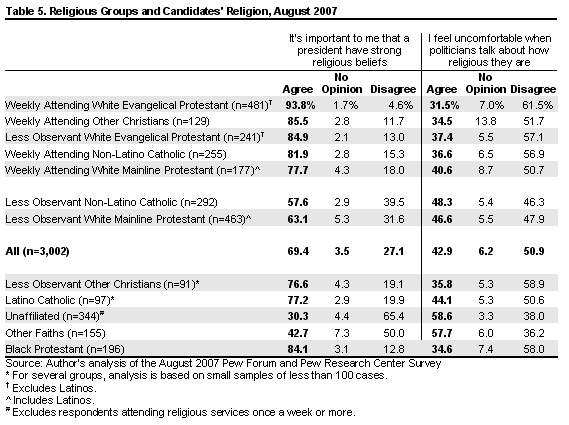
If you turn to Table 5, we have another set of measures on the role of religious expression in the campaign. The first set of columns are agreement or disagreement with the statement, “It is important to me that the president have strong religious beliefs.” You can see, looking at the “All” row in the middle of the table, that a very high proportion of Americans agree with the notion the president should have strong religious beliefs. In fact, more than two-thirds think that’s a good idea. This is not a new finding. Pollsters have found this pattern for a long time, but it apparently hasn’t diminished in the face of the extensive discussion of faith and values in the campaign.
Notice that virtually all groups have majorities of people who think it’s a good idea for presidents to have strong religious beliefs. But not all groups: The unaffiliated are not so excited about this idea.
But look toward the right-hand columns, the final three on Table 5. This is a different question. It’s also agree/disagree: “I feel uncomfortable when politicians talk about how religious they are.” Again, if you look at the “All” row, you’ll see a much more evenly divided opinion. About two-fifths of Americans agree that they feel uncomfortable when politicians talk about how religious they are. Just about half disagree, which is to say apparently they feel comfortable with that kind of discussion.

Video Highlight
http://blip.tv/scripts/flash/showplayer.swf?enablejs=true&feedurl=http:%2F%2Fpewforum%2Eblip%2Etv%2Frss%2F&file=http:%2F%2Fblip%2Etv%2Frss%2Fflash%2F638306&showfsbutton=false&brandlink=http:%2F%2Fpewforum%2Eorg&brandname=Pew%20Forum&showguidebutton=false&showfsbutton=true&showplayerpath=http:%2F%2Fblip%2Etv%2Fscripts%2Fflash%2Fshowplayer%2Eswf Interest in Faith-Talking Candidates (00:38) Watch more event video on the multimedia pageThe answers to these two questions are interesting if you put them together. On the one hand, the overwhelming majority of Americans think it’s a good idea to have a president with strong religious values, but many Americans don’t want to hear about it, at least not from the candidates themselves. There does seem to be a lot of interest in the religious beliefs of candidates, just like there’s interest in religious expression in the campaign. There is a great deal of tolerance for this kind of talk on the part of religious voters, but there are limits to that talk.
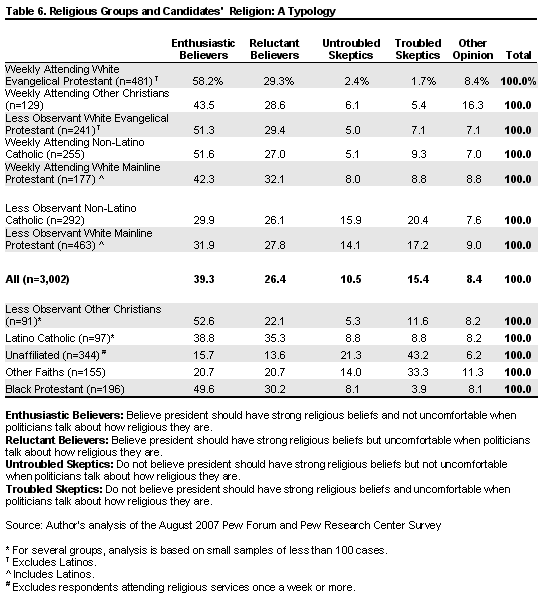
If we turn to the next table, Table 6, we combined those two measures, and we ended up with four different categories. I don’t know that the titles for these groups are particularly fortuitous. In the first column are what we call the “enthusiastic believers.” These are people who believed that the president should have strong religious beliefs, and they felt comfortable with the candidates telling us about that. The “reluctant believers” are people who thought the president certainly should have strong religious beliefs but felt uncomfortable in hearing candidates talk about them. The “untroubled skeptics” are people who didn’t think religious beliefs were all that important a qualification to be president, but it didn’t bother them when candidates talked about their faith. Then finally, the “troubled skeptics” are people who felt uncomfortable and didn’t think the president should necessarily have strong religious beliefs.
If you put those things together, you get a sense of both the acceptance of these types of ideas, but also the limits on them. If you look at the “All” row, about two-fifths of Americans are “enthusiastic believers.” But a quarter, 26%, are “reluctant believers.” The “untroubled skeptics” are about 10 percent of the public, and about one-sixth, or 15.4% of the population, are “troubled skeptics.”

Video Highlight
http://blip.tv/scripts/flash/showplayer.swf?enablejs=true&feedurl=http:%2F%2Fpewforum%2Eblip%2Etv%2Frss%2F&file=http:%2F%2Fblip%2Etv%2Frss%2Fflash%2F638305&showfsbutton=false&brandlink=http:%2F%2Fpewforum%2Eorg&brandname=Pew%20Forum&showguidebutton=false&showfsbutton=true&showplayerpath=http:%2F%2Fblip%2Etv%2Fscripts%2Fflash%2Fshowplayer%2Eswf Risks of “God Talk” (00:52) Watch more event video on the multimedia pageIf you look at this by the religious groups, you see some interesting patterns. Those strong Republican religious constituencies tend to be “enthusiastic believers,” but so do some of the Democratic constituencies, particularly black Protestants down toward the bottom of the table. But every single one of the Republican constituencies, and most of the Democratic constituencies, have large minorities of members who are in the “reluctant believers” category. So there’s some limit to how much candidates can talk about their faith without incurring the displeasure of the very voters they are trying to appeal to.
We talked a little bit about this issue yesterday when we considered Mitt Romney and his forthcoming speech. These data would suggest it would be very valuable to the Romney campaign if he could convince people he had strong religious beliefs, but there are costs as well because there are people who feel uncomfortable about having him explain this faith in detail.
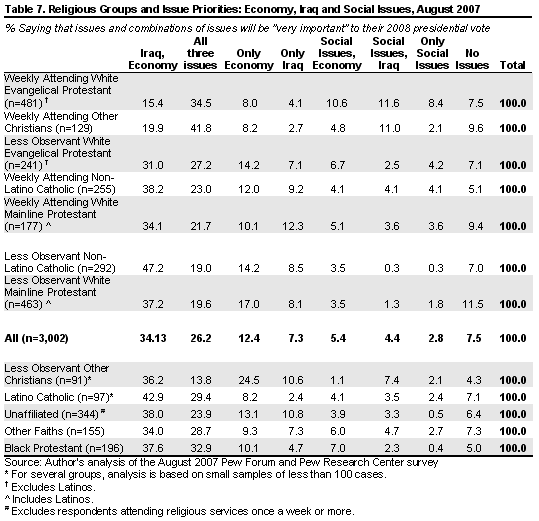
Let’s look at one more table, and then we’ll talk about the primaries very briefly. This is a very complicated table. I apologize for its complexity, but blame the world, not me. Table 7 looks at the issue priorities of religious groups. In our annual trend survey, we ask people how important they thought different issues would be for their vote in 2008. We ask about foreign policy issues such as the war in Iraq; we ask about the economy; and we ask about social issues such as abortion and same-sex marriage. What this table does is take the individuals who gave a “very important” answer to any one of those issue questions and combine them.
So for instance, the very first left-hand column is labeled “Iraq, Economy:” Those are people who said the war in Iraq would be very important to their vote, but so would the economy. These are people who have two kinds of priorities, both foreign policy and economy priorities.
The next column in, where it says “All three,” has those people who think all the issues are important. If you go way over to the end of the table, we have the “No Issues.” Those are people who apparently didn’t think any of these issues were important. Now maybe that’s because we didn’t ask about their hot-button issue – we didn’t ask about the environment, or we didn’t talk about Major League Baseball, or important issues that they care about. Or it could be that these are people who are just not very attentive and not clued in to the campaign yet.
What’s interesting about this pattern, though, is if you look at all the different combinations, you can see how complicated the issue agenda is for Americans. A few Americans are single-issue voters. You can see examples of that. For instance, the third column in are people who said, “Only the economy is very important to my vote.” The single-issue economic voters would be in that category, and then if you go way over to the far side you can see social issues. But most voters have combinations of these issue priorities.

Video Highlight
http://blip.tv/scripts/flash/showplayer.swf?enablejs=true&feedurl=http:%2F%2Fpewforum%2Eblip%2Etv%2Frss%2F&file=http:%2F%2Fblip%2Etv%2Frss%2Fflash%2F638304&showfsbutton=false&brandlink=http:%2F%2Fpewforum%2Eorg&brandname=Pew%20Forum&showguidebutton=false&showfsbutton=true&showplayerpath=http:%2F%2Fblip%2Etv%2Fscripts%2Fflash%2Fshowplayer%2Eswf Multi-Issue Voters (02:40) Watch more event video on the multimedia pageLet me talk a little bit about some of those combinations to give a sense of what is motivating these particular voters. Overall the economy and Iraq are the most important. More than a third of Americans list that combination as their top priority. But if you look at the Republican-leaning groups, particularly the weekly attending evangelical Protestants and that polyglot group of weekly attending “other Christians,” the Iraq/economy combination is much lower. What those people are interested in is all three issues, so they combine social issues with a concern for foreign policy and a concern for economic issues.
That helps explain, I think, some of the patterns that many people have puzzled over, including the fact that evangelicals have supported candidates such as Rudy Giuliani. If a significant number of these voters actually care about a variety of different issues and don’t give exclusive priority to social issues, it makes a certain amount of sense that they would evaluate candidates differently. When it came to Rudy Giuliani, maybe two out of three ain’t bad.
But if we go down to the Democratic groups, notice that the Iraq/economy group is very large. That tends to have a plurality, large pluralities, in all those groups. But there are significant minorities among black Protestants, Latino Catholics, and the unaffiliated who also think all three of those issues are important.
To go back to our groups in motion, less-observant Catholic and mainline Protestants, we see the dominance of the Iraq/economy combination. These groups may very well be moving on the basis of those issues. There may be a religious component to it, but maybe not. Those particular groups may, in the language of social science, be a bit over-determined, with a number of different variables moving them politically.
The campaigns, of course, worry a great deal about these combinations of issues. As you all know, targeting has gone beyond an art to become a science these days, both in the primaries and the general election. Candidates and parties and their interest-group allies can do very precise targeting of different combinations of voters. Gone are the days when one had to make a general appeal and hope one could collect enough votes to win the election. Now one can make a lot of very precise appeals. This is the kind of complexity that campaigns see when they try to target voters.

Video Highlight
http://blip.tv/scripts/flash/showplayer.swf?enablejs=true&feedurl=http:%2F%2Fpewforum%2Eblip%2Etv%2Frss%2F&file=http:%2F%2Fblip%2Etv%2Frss%2Fflash%2F638310&showfsbutton=false&brandlink=http:%2F%2Fpewforum%2Eorg&brandname=Pew%20Forum&showguidebutton=false&showfsbutton=true&showplayerpath=http:%2F%2Fblip%2Etv%2Fscripts%2Fflash%2Fshowplayer%2Eswf Green: “Campaigns Really Do Matter” (03:12) Watch more event video on the multimedia pageYou’ve been very patient to let me work through my tables. Let me just end with a couple of comments about the primaries. We’ve been really focusing on the likely impact of the religion factor in the 2008 general election. But of course, religion can matter in the primaries. Given the fact that we have very competitive races in both parties, religious constituencies are part of the mix. We have in front of you on the table two reports from the Pew Research Center, one of them released yesterday on the Democratic primary race, which discusses religion in some detail and then one on the GOP race that will be released in 20 minutes – it’s embargoed until about the time I finish talking. But Michael’s already been blogging; so the word is already out.
There’s a lot of rich detail in there, and perhaps we can talk a little bit about that later, but what’s been interesting about the role of religion in the primaries thus far is how little impact it has appeared to make. On the Democratic side, of course, Senator Clinton has been ahead, and she’s been ahead in all of the religious groups in national polls up until recently and ahead in most polls even now. On the Republican side it’s been a little more interesting: white evangelicals have been a bit up for grabs; sometimes Giuliani is a little bit ahead; sometimes it’s more of a tie between Giuliani and other candidates. But if you look at white Catholics and mainline Protestants, Giuliani’s national lead was replicated among them.
In some sense, though, national polls about primary preferences can be misleading because we don’t have a national primary. We have a national general election, or at least we have 50 state elections that occur all in the same day, but primaries are individual events that occur in a sequence. What these reports do is show how the different religious groups may be lining up in these early caucus and primary states. There are, in fact, some divisions. For instance, the report that will be released momentarily shows that – no big surprise, but it’s nice to have strong data – that part of Governor Huckabee‘s rise in Iowa comes from the fact that he’s garnered a great deal of support from white evangelicals in that particular state.
We see fewer patterns, though, when we move away from Iowa for both the Democrats and the Republicans. It may very well be because the campaign hasn’t arrived in full force in New Hampshire and South Carolina yet, which raises one final point that pertains to the primaries but also to the general election: Campaigns really do matter. This year, when we have religious groups apparently moving around, campaigns are particularly important. The nature of the candidates, the issues they stress, the way they conduct their campaigns, and the vast amounts of money they will spend may make a tremendous difference in determining where these particular religious groups end up next year.
Thank you very much.
CROMARTIE: Thank you, John. We’re grateful that two of the best political commentators on American politics and religion are here with us to respond to John’s data, and so I’ve asked Michael Barone and E.J. to comment. Michael, thank you for being with us; you’re first.
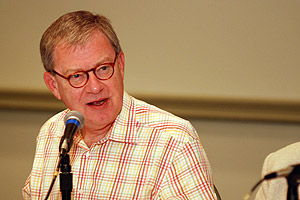
MICHAEL BARONE, U.S. NEWS & WORLD REPORT: Thank you very much. It’s nice to be with you this morning to have the opportunity to break the Pew Center’s embargo by 18 minutes on this material. Of course, we’re all here with our laptops.
I have a few observations on this data which the Pew Research Center has provided over the years, which I think is terrifically valuable and helpful for understanding. One of the things that struck me when I was looking at John’s tables was an historical comparison that parallels some of the ones we were making yesterday between 1960, when religion played an important part in voting, and the current epoch, when it seems to be doing so as well, and how different the divisions in 1960 were from the divisions we’re living with today.
On John’s Table 1, I noticed that less-observant white Catholics and less-observant mainline Protestants vote almost exactly the same way; they’re the people in the middle. They’re the ones that basically produce the national average. They’re split just by a small margin for George W. Bush over John Kerry. Those were two of the groups who were the most opposite in the 1960 race, with Catholics running about 78% for Kennedy and white Protestants 63% for Nixon. They were totally divided along sectarian lines, and now they’re the vanilla of American politics. The outliers are white evangelical Protestants on one side and black Protestants on the other, which, when you reflect on it, are people whose theological views are much the same, but whose voting behavior is quite different.
I have said and written that between 2004 and 2006 we moved from one period in politics to another, from a period of trench-warfare politics, in which we had two armies lined up in a culture war in the trenches, nobody deserting to the other line; the only question was how many people you could muster to go over the lines and capture that very narrow margin of contested territory that meant the difference between victory and defeat. Both parties ran the ’04 campaign on that theory, spending an awful lot of time, money, and volunteer effort identifying new voters, getting out the vote, turning out their people, not trying to influence undecided voters or people who were lightly committed on either side on the theory – and correct theory, I think, in ’04 – that there weren’t very many of them, and it was much more important to turn out your people. They had huge success. John Kerry got 16% more votes than Al Gore; George W. Bush got 23% more popular votes than he got four years before. Those are both tremendous mobilizing jobs by the two political parties and their allies.
I think we passed, sometime between ’04 and ’06, into a period of what I call open-field politics, in which politicians are moving around and voters are moving around, and we’re seeing a lot of different possibilities, permutations and combinations. I think the data John’s presented this morning substantiates that. Less-observant white evangelical Protestants voted 72% for Bush in ’04; generically, they’re favoring the Republican by 39 to 34 now, which is a pretty lukewarm margin. It brings to mind the Teamsters Union business agent who was at the hospital and received a bouquet of flowers with a card that read, “The executive board wishes you a speedy recovery by a vote of nine to six.” (Laughter.) That indicates huge movement, or potential movement, among a group of people, and we see this with some other groups as well.
[Table 3]
The groups he does best with are less-observant Catholics and less-observant other Christians; I guess they’ve got his number. (Laughter.) A Giuliani White House will not have people greeting each other, as David Frum reported, staffers greeting each other at the Bush White House by saying, “Missed you at Bible study.”
That’s the wonderful ambivalence that people have. They want to have candidates that are highly religious, and they want to hear about it somewhat but not too much. As you look around the field of candidates in this election, it’s fascinating: We do have some odd or interesting combinations. We’ve got a Mormon running, of course, and that seems to be vastly more important to people than it was when his father was running 40 years ago, as a number of us commented yesterday. We’ve got a glaringly non-observant Catholic. If Rudy is a cafeteria Catholic he’s coming in for a glass of water and moving to the other side, it would appear. We’ve got a graduate of Ouachita Baptist College, which has not as yet in the history of our republic produced a president of the United States but now has some possibility of doing so.
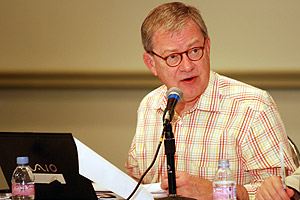
On the Democratic side we have Hillary Rodham Clinton, who has been an active Methodist since her grade school and high school days; Methodism being one of America’s great mainline denominations, the big winner in the religious competition of the middle and late 19th century. She has her roots in that but also in the feminist movement. And we’ve got Barack Obama who, somewhat embarrassingly for all concerned, attends a black-nationalist church of an almost separatist point of view. He won’t invite the pastor out to appear on his behalf. So the guy whose basic pitch is, “I want to get beyond polarization and talk about the things we have in common,” has chosen to join a church – it’s not his family church or anything of the kind – that seems to say the opposite. I don’t know entirely what to make of this, but I’m fascinated by it.
How is this going to play out? In this period from 1995 to 2005, the degree of religious observance was the demographic factor most highly correlated with voting behavior to an extent that is unusual in the history of voting in our republic. I think most people feel a little uncomfortable about that just as we feel uncomfortable probing Mitt Romney about the state of his theological beliefs. And yet, it has correlated highly with the issues that people care about. Many of the issues people care about have moral content and relate to things that are important to them and their personal lives. We can’t prohibit them from voting on that basis if they choose to do so, as evidently they do.
I think the polarization has been strengthened and exacerbated by the happenstance fact that our last two presidents, Bill Clinton and George W. Bush, were both born in the first year of the baby boom, 1946; both graduated from high school in 1964, the class with the peak SAT scores. Both of these men happen to have personal characteristics that people on the other side of the culture divisions just absolutely hate. Large numbers of Americans, mostly a non-overlapping group, cannot stand either man. That has increased the polarization, and it’s provided some basis for Obama, for example, to campaign as the beyond-polarization guy. I’m not a boomer. I like to say the good news is that the baby boom generation is going to die out; the bad news is that I’m going to die at about the same time. (Laughter.)
But I think we’re potentially moving beyond that, and John’s data suggest there are a lot of possibilities open here. I think the general election campaigns are going to go back to aiming at undecided and lightly committed voters because there’s going to be a much larger potential percentage of people who are uncommitted and might be persuaded. I think we’re still going to see religion and degree of religious observance highly correlated with voting. Looking at this data, it seems to be somewhat more highly correlated than I might have guessed; this basic hierarchy of groups and degree of Republicanness or Democraticness seems to be similar. But I think we’re going to mix it up, and I think the correlation will probably decrease in this election and may do so over time, in ways that we can’t entirely predict.
Let me make a couple of points off this still-embargoed-for-the-next-six-minutes Republican poll here. Number one, Iowa; God bless us, every so often I go through the Constitution and look for the section that says Iowa and New Hampshire vote first. I haven’t found it yet, but I’m still looking. Nonetheless, the 200,000 or so people voting in Iowa will make a decision that will have a terrific effect on the 303 million of us other people. In Iowa, clearly, the importance of white evangelical allegiance is huge.
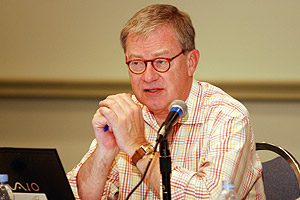
The Pew poll here confirms the data I extrapolated from the ABC-Washington Post poll of about a week ago. In that poll, about 38% of the people were white evangelicals, Protestants; among them, Huckabee was getting 44% of the vote. Among the 62% of likely caucus goers who were not white evangelical Protestants, Huckabee was getting 12% of the vote. What this data shows here is the same thing among white evangelical Protestants, who are, again, 38% of the electorate: Huckabee’s at 40%. He’s at 15% among other groups, so he’s kind of a splinter candidate among the other groups, and not quite a unanimous but an overwhelming choice. Getting nearly 50% of the vote among a large, identifiable group of voters in a five- to seven- or eight-candidate field is a real high percentage. That’s fascinating; interestingly, it hasn’t happened as much in other states. In New Hampshire, where only 18% are white evangelical Protestants, Huckabee gets 24% of their votes; New Hampshire basically has a historical heritage of smugglers and tax evaders, and they’re more interested in avoiding government impositions and less interested in strong religious belief.
But the data I find most amusing here – and you don’t see many poll results that are funny, but this one to me is. White evangelical Protestants are 53% of South Carolina Republicans, which will not surprise many people who’ve spent time in South Carolina. They have reached a decision; they have come to – What are their numbers? Thompson, 19%; Giuliani, 18%; Romney, 17%; McCain, 15%; Huckabee, 12%. They’re all over the place; there’s not a statistically significant difference, or not much of one, between the top candidate and the bottom candidate.
To me, that suggests something about ’08, which is that an awful lot of people haven’t made up their mind; are pushed one way or the other; are not entirely certain which party’s presidential candidate they’re voting for within their parties; and are quite capable of moving around a lot. We don’t know and probably can’t know what are going to be the dispositive issues that will push people over a line or from one voting decision to another. But I think it’s a year of great uncertainty. Four years ago, I would have told you with great certainty that neither party’s presidential candidate, barring an absolute collapse, was going to get more than 52% of the vote or under 48%, and I would have been right. There are many different outcomes possible now, and the data John’s presented here gives us some very interesting insights into a very uncertain year.
Thank you.
CROMARTIE: Thank you, Michael.
Before I introduce E.J. Dionne, I should let you know that E.J. has a new book coming out with Princeton University Press called Souled Out: Reclaiming Faith and Politics After the Religious Right. E.J., when will that book be out?
E.J. DIONNE: February 1, they tell me, it’ll be in the stores. Thank you for the plug.
CROMARTIE: I’m glad to plug.
Ladies and gentlemen, we’re delighted to have E.J. Dionne of The Washington Post and the Brookings Institution and Georgetown University and of the Pew Forum.
DIONNE: I have a lot of kids; I need to support them somehow.
CROMARTIE: With all those affiliations, E.J., we’re glad you had time to come join us. Thank you.
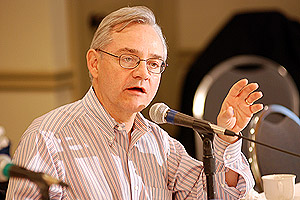
Speaking after John Green on this subject is like speaking about football after John Madden, or fashion after Yves St. Laurent, or cooking after Emeril Lagasse, who some of you may know is also from my hometown. And saying anything about demographics and politics after Michael Barone is something like speaking about math after Euclid. If you name the address where you grew up, Michael can tell you how the precinct votes, and we can play that game at some point here. I’ve actually always wanted to have a fundraiser where you’d have a competition like that with Michael, Congressman Tom Davis, and Chris Cillizza of The Fix. I think the three of them could give each other a great run for their money. None of that will intimidate me from drawing sweeping conclusions, however.
There are three broad conclusions I want to draw, and I’ll explain how I get there. First of all, I think the ’04 white evangelical vote for George Bush will never reach that level of support for one candidate for a very, very long time, perhaps ever. I think the metaphor or the analogy may be to the Catholic vote for Kennedy in 1960; 78% as Michael mentioned. The Catholic vote has never been like that since. Even Lyndon Johnson, in his landslide, appears to have run slightly behind Kennedy’s share of the Catholic vote four years later. So while white evangelicals will remain a largely conservative and Republican group, the percentages you saw in ’04 I think will be very difficult to reach again.
Secondly, I believe, and this will be a controversial statement, that the era of the religious right is over. Now, as Bill Clinton would say, I suppose that depends on what the meaning of the words “religious right” is, but I believe the religious right, viewed as a conservative political movement within the Republican party that rose from 1978 or 1980, is breaking up, in significant part because the evangelical community itself is changing and also because the issues confronting the country are changing. Again, I’m not predicting that this group will suddenly shift overwhelmingly to the Democratic Party, but I think we’re going to see a very different style of politics in the coming years. Therefore, I believe the understandings of religion and politics we’ve had since 1980 are going to change. I think the past, in this case, does not predict the future, and some of what we see in the numbers John ably presented suggests that. I’m going to broaden each of those points.
I want to begin by going to John’s tables and calling your attention to a few numbers. First of all, I think all three of us believe that while we speak a lot about white evangelical Protestants, because they have had such a big role in our politics, the two swing groups in the religious world and American politics are Catholics in general, because Latinos swing around as well, and mainline Protestants. In some sense, and this is an over-simplification, they’re both 40-40-20 groups. You can assume each party will get somewhere around 40% from these groups, but there is a swing vote of about 20%. I think even between ’04 and ’06 you saw some swinging, in this case, in the Democratic direction. I think someday Michael will organize a session that focuses on the swing groups in politics; maybe it’ll be a good session for this spring, when we know the nominees. This becomes quite clear in John’s Tables 1 and 2.
Secondly – and I’m going to come back to this many times because this is a pet peeve of mine – we always speak of evangelical Protestants as being a conservative group; that happens to leave out the most religious group in America, perhaps, which is African Americans and, as I believe Michael pointed out, theologically African Americans are often quite close to white evangelical conservatives. So on Sunday, they may pray similarly but on Tuesday, they vote very differently. I think the statement, “evangelical Protestants are conservative,” is misleading. I’m on Table 4, “Religious Groups and Religious Expression in the Campaign,” where the black Protestants and weekly attending white evangelical Protestants both believe too little attention is paid to religion in the campaign. Similarly, on the question of should presidents have strong religious beliefs, note that black Protestants in the Democratic group at the bottom of that table stand out as believing presidents should have strong religious beliefs.
Lastly, I want to underscore on Table 6 why I think religion in politics is much trickier than we often suggest; John groups enthusiastic believers, reluctant believers and so on. If you put untroubled and troubled skeptics together, that’s 26% of the electorate. So if anyone wonders why Christopher Hitchens and Sam Harris, and all those folks have sold so many books, 26% is a very significant number of Americans. If you combine that 26% with the reluctant believers group, that is over a majority. It is simply not true that if you go out and say how religious you are and talk about it all the time, you are automatically appealing to a majority of the electorate. I think it’s very important to pay heed to Table 6. It’s also amusing, and I will draw no conclusions from this, that the group John chooses to call reluctant believers seems to loom especially large among weekly attending mainline Protestants and Latino Catholics.
Let me turn to the idea that the 2004 election will mark the high point of polarization around issues related to religion and culture. The simple reason for that is that other matters are crowding onto the agenda and pushing some of these issues into second place: economic and security, foreign policy, terrorism, health care and, of course, the Iraq War. It was already visible in the 2006 election that these issues were looming larger. As both Mike and John have referred to, the very Republican field in 2008 suggests things are very different from the past. I won’t belabor why Rudy Giuliani and John McCain and Mitt Romney and, to some degree, even Fred Thompson are not perfect candidates for the religious conservatives.
But also, I think Huckabee is very interesting because Huckabee, a former Baptist minister who does have strongly conservative positions on the social issues, has actually been broadening the evangelical agenda. He speaks critically of Wall Street; he has linked his Christian commitment to a concern for the poor and their access to education and health care. I think Huckabee may understand better than most politicians how much the religious conversation is changing within his own evangelical community. I think the most interesting criticism of Mike Huckabee came from Fred Thompson, who called him a pro-life liberal. There are, indeed, times when Mike Huckabee sounds a little bit like our friend Jim Wallis. So I think you’re already seeing a lot of change within the Republican Party.
It’s also important to underscore that while there is no question that the new religion gap John Green has identified between those who are very observant and those who are not is an important part of our politics, we need to qualify that just a little bit. On the one hand, if you look at the two strongest groups that are most obviously split by this issue – those who attend religious services more than once a week and those who never attend – the religion gap is very clear: Those who attend more than once a week voted 64% for George Bush in ’04; those who never attend voted 62% for John Kerry.
But I would just point out that, taken together, these two groups account for only three voters in 10: the 16% of Americans who go to religious services more than once a week, and the 15% who never go. Again, there is a definite relationship, or there was in ’04, between Republican leanings and church attendance, but it is not as strong as one would assume, looking at the most and least religious. Weekly attenders did back Bush 58-41, a healthy majority certainly, but not as large as the even more observant. Those who attended once a month split their votes almost evenly, 50% for Bush, 49% for Kerry; those who attended religious services a few times a year backed Kerry 54 to 45%. In many ways this proves that John is right about a new religion gap, but I think we need to put it in this context.
I also think – I’m stating the obvious here – it’s very important to remember we’ve spent so much time paying attention to religion that we forget other demographic factors divide the electorate even more profoundly. Race, certainly, divides the electorate more profoundly: White voters for Bush, 58-41; African Americans for Kerry, 88 to 11%. Latinos, whom I’ll say more about in a moment, are a fascinating group because it’s almost impossible to talk about Latinos as a single bloc; they are different by ethnicity, they are different depending on the state they live in. But clearly, the racial and ethnic splits are important.
Also, I think it’s important not to stereotype white evangelical voters. I just want to share one of my favorite findings. Father Andrew Greeley and Professor Michael Hout wrote an interesting book recently called, The Truth about Conservative Christians. Before you stereotype white evangelical Christians, consider that Greeley and Hout found that conservative Protestants were more likely to watch PBS news programs daily than other Americans, with the exception of those who say they have no religion, who watched at about the same rate. So the religious and the irreligious seemed to be united around PBS. To quote Greeley and Hout, “If one finds the temptation irresistible to picture all Jesus people as religious fanatics, one should picture a fifth of them glued to PBS stations every evening.”
The Latinos: One of the most important facts about the Latino vote is the sectarian divide. Bush won between – there were a couple of polls on this – 53 and 57% of Latino Protestants in 2004. He won only 33% of Latino Catholics. If Republicans want to make expenditures on the side in their own interest, they might try to convert more Latinos to Protestantism because there is clearly this very strong correlation. I’m not suggesting that, and it would probably be illegal. I think it’s important to note that this is one group that really is on the move politically because of the immigration fight in Congress, and that the gains President Bush clearly made among Latinos are now in jeopardy, including the gains among conservative Latino Protestants.
One other note on white evangelicals I think is important: There is an overlap between the rise of white evangelicals in the Republican Party and the shift of the South to the Republican Party. This regional accent, if you will, is very important; a 2006 Pew Forum survey found that 52% of white evangelicals live in the South compared with just 31% of non-evangelicals. For historical purposes, I think it’s important to underscore that white Southerners began to turn to the Republican Party long before the rise of the religious right. In some ways, the rise of religious conservatism confirmed a shift that was already taking place, rather than creating the enormous shift itself. The exception, from ’64 forward, is of course Jimmy Carter’s election in 1976, and he was the first openly evangelical Protestant in a long time to run for the White House.
To further underscore the limits of talking only about religion, there is still a class split in American politics, an income split. Bush won 63% of the votes from those who earned over $200,000; only 36% from those who earned under $15,000. He won 57% from voters in the $100,000 to $200,000 range, but only 42% among those earning $15,000 to $30,000. Obviously, there’s some overlap in race and ethnicity in those numbers but the class split has not disappeared.
There are also fascinating differences by state, and I had a long list of these, and I won’t belabor you with them, but I actually once took apart the 2004 exit polls to look at how the religious question played state-by-state. You’ll find that the religion gap barely exists in Louisiana; is enormous in Minnesota and Washington State; and that California was the only state in which Bush failed to secure a majority among weekly churchgoers. Now, all these may have demographic explanations. In Louisiana, the Democratic share among regular church attenders was boosted by African Americans and, to some degree, Cajun Catholics. Minnesota and Washington have relatively small African-American populations, and in California the Democratic vote is boosted by Latino Protestants.
There are also great differences in religious behavior state-by-state, which helps us understand why states behave differently. Over half the voters in Georgia and Louisiana attended religious services at least weekly, and a quarter to a fifth attended more than once a week. Only 7 to 8% of those voters claimed never to attend religious services. By contrast, in California and Washington, I’m just using these as examples, over half the voters attended religious services occasionally or never, including a fifth and a quarter who never attend. The contrast between the religious patterns of the Deep South and the Pacific Coast offer some useful clues as to the differences among these regions.
One more point about ’04; then I want to talk about ’06, and I’ll conclude. I think it’s very important to understand – and maybe I’m making a controversial point, although I don’t believe so – that John Kerry was not defeated in 2004 by the religious right. Yes, there was enormous mobilization; it does appear that the turnout of religious conservative voters went up between 2004 and 2008. But actually, Bush won that election in the middle. Consider just a few findings from the exit polls: 38% of those who thought abortion should be legal in most cases voted for George Bush. Bush got 22% from voters who favored gay marriage; astonishingly, 52% from voters who favored civil unions. If you compare the 2000 and 2004 exit polls, Bush increased his vote by only one percentage point among voters who attend religious services once a week or more, but he gained four points among monthly attenders and three points among those who attend a few times a year; four points among those who never attended religious services. Put simply, the swing to Bush was higher among the less-religiously observant than among the religious. I think, and I won’t belabor this, that some of that shift owes to either a successful discrediting of John Kerry or a certain percentage of voters who still, in 2004, trusted George Bush more to deal with the issue of terrorism.
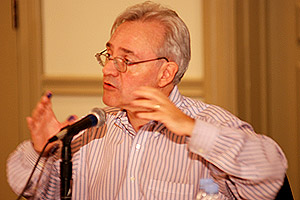
Now, what happened in ’06? I just want to read two accounts about ’06 that are quite different. A reporter for the Philadelphia Inquirer wrote a very good front-page analysis, which began with this lead: “A minor miracle occurred this month: The ‘God Gap’ in American politics narrowed.” But 10 days earlier, Scott Keeter of the Pew Research Center was just as definitive in declaring “The God Gap widens;” same election, two smart analysts, exactly opposite conclusions. Who was right? Both accounts were based on fact and not speculation. Here’s more from Fitzgerald of the Inquirer: “While the most religious voters in recent years have tended to favor Republicans, a slice of them voted Democratic in the November 7th midterm congressional elections. The shift has raised eyebrows among pollsters and strategists.” He reported that Democrats took back the Catholic vote they lost in 2004, trimmed the GOP advantage among weekly churchgoers, and even gained ground with the most loyal segment of the Republican base, white evangelicals.
By contrast, Scott Keeter found the Democratic gains in the election were concentrated among non-Christians and secular voters, suggesting there was a larger political divide between Christians and the rest of society. Here is some of Keeter’s data: The GOP held onto voters who attended religious services at least once a week, 55% Republican versus 58% four years ago; less frequent churchgoers were even more supportive of the Democrats than they were four years earlier. Occasional churchgoers, the same way; thus, the gap in Democratic support between the most and least religious has grown from 16 percentage points in 2002 to 24 percentage points today, and so on.
Who was right? I think as a technical matter, Scott Keeter was clearly right because the religion gap grew. But if you read Fitzgerald’s claims carefully, he only said that a slice of the religious vote had gone Democratic, and Democrats did indeed post gains among religious voters in ’06, including white evangelicals. In other words, every assertion Fitzgerald made was true even though, in fact, the God gap widened. I refer you, for more excellent analysis on this, to John’s book this year, The Faith Factor.
I went and looked at three key races. Just very quickly, I think these races tell us a lot about the religion gap. In Ohio, Ted Strickland ran for governor for the Democrats against Secretary of State Ken Blackwell. Strickland was a Methodist minister; he spoke often about his faith. Ken Blackwell was closely aligned with religious conservatives in the Senate race. Sherrod Brown ran against Mike DeWine; Sherrod Brown a liberal, Mike DeWine moderately conservative.
If you look at Strickland’s numbers he swept the state, with 60% of the vote; Brown won with 56%. Much was made of Strickland’s strength among religiously active voters, and indeed he won 38% of Ohio voters who attended religious services more than once a week, a seven-point gain over Kerry, and he posted a 19-point gain among those who attended religious services weekly; he got 55%. That is a very significant shift. But Strickland gained even more among the non-religious: 81% among those who never attended religious services, an 18-point gain over Kerry, and he picked up 11 points on Kerry among occasional attenders. In other words, even though Strickland gained substantial ground among religious voters, the religion gap was actually higher in ’06 than it was in ’04 because of the profound Republican weakness among non-religious voters.
A very, very similar pattern, I won’t go into details, applied in Pennsylvania where Bob Casey did post big gains among Catholics, and yet he, a pro-life Democrat, gained even more among the non-religious. The exception that proves the rule, a phrase I’ve never really understood, is Virginia, where Jim Webb very narrowly beat George Allen. You cannot say that the religious right was unfaithful; there was no change between ’04 and ’06 in the religious composition of the vote measured by strength of church attendance or attendance at religious services. George Allen did at least as well, if not even better, than George Bush among highly observant voters. The big difference is that the issues changed. Iraq was a huge issue; 37% of the electorate in Virginia said they strongly disapproved of the Iraq War, and 91% of those folks voted for Jim Webb.
It seems to me that – I agree with Michael, and I like his notion of open-field politics – 2006 does not necessarily portend the beginning of a new Democratic era. I think the Democrats had a lot of votes on loan in that election, and they’re going to have to earn them, and we all know how dangerous loans are these days, though I do think they’re in a better position than some of those sub-prime mortgages are. But they definitely have an enormous opening, and you’re seeing very slow but steady changes in the party affiliation of the electorate. I think ’06 did close an era in American politics. Americans seemed tired of culture wars, tired of polarization around cultural issues, tired of the use of these issues as electoral cudgels. I think the culture wars and the religious wars exploit our discontents; the task of politics is to heal them. And I think right now there’s a great hunger across religious denominations and across levels of political commitment for a politics of remedy to replace a politics of polarization.
Thank you.
CROMARTIE: Thank you, E.J. Thank you very much
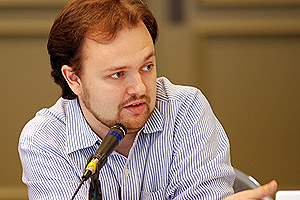
ROSS DOUTHAT, THE ATLANTIC: Michael Barone spoke to this, but I was wondering if, John, you could talk a little more about this. The numbers in the trial heat between Rudy Giuliani and Hillary Clinton seem to confirm, at least to a certain extent, the conventional wisdom about what a Giuliani-Clinton race would mean for re-shifting the political landscape. You see Clinton having the potential to make possibly substantial gains for the Democrats among evangelicals, Catholics, mainline Protestants and so forth. The only areas where Giuliani seems to have the potential to make gains for the Republicans are among the less devout, less church-going.
It looks to me like – and maybe I’m getting this wrong – Giuliani is improving on Bush’s numbers among the unaffiliated and other faiths, if you compare his share to Bush in ’04. I wonder if that’s how you see things shaping up. It seems to at least possibly disprove the contention that because of Iraq or Iran or foreign policy issues more generally, Giuliani could hold on to something approaching the same share of the evangelical vote that Bush won.
GREEN: I think that’s insightful, Ross. This does tend to confirm the conventional wisdom, particularly on Giuliani as a different kind of Republican candidate than we’ve had in the past, one who could appeal to the votes in the middle that both Michael and E.J. talked about, people who are moving around, but perhaps at the cost of not getting the same level of support from some of the key religious constituencies that backed George Bush. It also confirms a bit of the conventional wisdom on Senator Clinton, who has made a big effort to appeal to religious voters. One of the reasons I am interested in these particular numbers, although they’re not definitive by any means, is that they do suggest the possibility of the structure of faith and politics changing because of unusual candidates who, in some sense, go against the grain of where their party could be.
The one big caveat here, though, is that the campaign hasn’t happened yet. It may very well be that Giuliani would have a very hard time in a real campaign in capturing a high percentage of these centrist groups, or groups that have been Democratic in the past. As E.J. pointed out, George Bush was able to do a good bit of that in 2004; he was able to extend his reach into groups that, on balance, voted Democratic. Whether Giuliani will be able to do that under the fierce attacks of a general election campaign remains to be seen. Likewise, it remains to be seen if Senator Clinton could really do better among highly religious voters under the same circumstances.
BARONE: Comparing Giuliani’s run with Bush ’04, evangelical Protestants are his biggest decline, in addition to weekly attending Catholics and weekly attending other Christians, which is a figure I think I said was an anomaly. This is in tandem with the July ’06 50-state polling by SurveyUSA. Jay Levy of SurveyUSA matched multiple candidates, including many people who turned out not to be candidates. If you want to know how George Allen runs for president against Mark Warner, that survey can tell you. (Laughter.) That survey showed Giuliani ahead of Clinton, whereas this one, in line with the October ’07 general results, shows him about five points behind.
But I compared the Giuliani/Clinton margins in the 50-state survey to the Bush-Kerry margins. Basically, Giuliani runs weaker than Bush in most of the South and the Great Plains states, Hillary Clinton carries Arkansas, but he runs stronger substantially in the Northeast and in particular in the states with the highest Italian American percentage: Massachusetts, Rhode Island, Connecticut, New York and New Jersey. Half of all Italian Americans live within 150 miles of New York City. On balance, in a close race, that looks like an electoral-vote plus for Giuliani because while he loses Arkansas, he’s competitive and better off than Bush was in large states in the Northeast, in particular, and the Great Lakes and Pacific Coast.
DOUTHAT: The numbers I’ve seen suggest he does run better in a New Jersey or a Connecticut, but that the gap Republicans face in those states to begin with is so large that even if he gains – So you think Giuliani could win –
BARONE: New Jersey was 53-46 in ’04. That doesn’t tell me it’s out of sight. Bill Clinton carried a New Hampshire that was 61% for George H.W. Bush in ’88. When you have open-field politics, a lot of big numbers can change in a particular state. So to say a 53-46 is unwinnable: I don’t think so.
DIONNE: Two quick things. One, there is some evidence from the polling that one of the constituencies that cares most about terrorism is white evangelical Christians, which is why Rudy Giuliani is picking up even in the primaries something like 20% from white evangelicals. There is clearly that element here. I don’t know whether that lasts through all the way to ’08, especially if, as I suspect might happen, the economy starts looming larger and larger as an issue between now and Election Day.
Secondly, just to call attention to John Green’s wonderful work in looking at white evangelicals: Many of you are familiar with his delineation of different religious groups; he divides them into three groups, traditionalists, centrists, and modernists. If you look at the white evangelical vote, about half are traditionalists and the other half are centrists or modernists, mostly centrists. The first half are reliably conservative Republicans. The second group is much more in play; it’s still marginally Republican. Again, most groups are not monoliths, and I think that’s especially true of white evangelicals. There will be a lot of play for the other half, the moderate or liberal half, or the liberal slice, of the evangelical vote.
BARONE: The ’04 campaigns assumed if you identified a potential new voter for Kerry or Bush in March, they’d vote that way in November. If I was running one of those ’08 campaigns, I would not so assume.
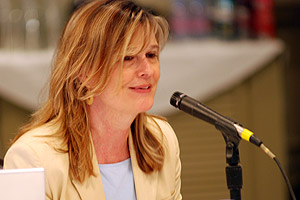
KATHLEEN PARKER, WASHINGTON POST WRITERS GROUP: You guys talk faster than I listen, and I’ve had my complete quota of numbers for the week this morning.
I think I’m the only person here who actually lives among the snake-handlers of South Carolina, so I wanted to make a couple of comments. It’s helpful when you go there, as reporters, to understand what a former statesman named Petigru once said, which was that South Carolina’s too small to be a nation, too large to be an insane asylum.
Just a tip, in the spirit of hospitality: If you’re going to South Carolina, and you want to get local color, flavor, and the real story of what’s going on among voters, go to Lizard’s Thicket. I see John nodding his head. You may know this; it’s a hangout where everybody goes for breakfast. And I do mean everybody; Kate Dawson, who’s the chairman of the state Republican Party, goes there every single morning to find out what people are thinking, so you don’t want to miss that.
CROMARTIE: What town, Kathleen?
PARKER: They’re everywhere; it’s a chain. You get two eggs, hash browns, bacon – that kind of breakfast – and you get people who “tawk laak this” all the time. But they’re good people, and they do go to church.
My question’s actually very simple, but it may involve a second question, depending on the answer. Is there a significant variation in church attendance between Democrat and Republican administrations? When people are feeling their cultural values are under attack, do they tend to go to church more? Is there a rise in attendance?
GREEN: Basically, there isn’t. Church attendance is very stable. I’m sure you’re all aware, there are some debates among sociologists about how accurate church attendance measures are, but whatever it is that’s being measured, it’s very stable. Changes tend to occur over long periods of time. Even one of the strongest critics of church attendance as a valid, accurate measure of what people actually do every week, Mark Chaves, a very fine sociologist now at Duke University, argues that whatever’s being measured has been very consistent since 1990. Between 1960 and 1990, he argues, as a lot of other analysts do, there was a decline in that level of church attendance. But since then, it’s been very consistent. So worship attendance doesn’t change very much by administration.
There is one change, though, and it doesn’t as much have to do with administrations as it has to do with crises. In periods of crises, church attendance does increase along with other measures of religiosity such as frequency of prayer. Right after 9/11 there was this dramatic increase in reported church attendance and prayer and Bible reading and all kinds of things. But that subsides when people adjust to whatever the problem was. I suppose, Kathleen, you could tie that to an administration but I think that’s more tied to events.
PARKER: No, I just wondered if it was more about culture than religion in some cases, whether these people go to the polls in greater numbers for a certain candidate, or that they associate with a church group more to identify with others who share their values. It sort of blows my theory, your answer does.
GREEN: Sorry about that.
DIONNE:Nathan Glazer talked about the rise of the religious right as a defensive offensive, and I think for a lot of people that’s what it was, a sense of exclusion from the main culture and a way of fighting back. But that was a long time ago.
On the church attendance thing and 9/11: There was a great mystery at the time because there were some polls that showed much more church attendance, praying and all of that. At the same time, there were later polls that showed there was no net increase, and if you asked, “Did you go to church last week?” there was no change. Andy Kohut and the Pew Forum, we sat down and wanted to solve this mystery. What we discovered is that people who already prayed quite a bit, or went to church quite a bit, went to church more after 9/11 so there was not necessarily a broad increase; it was just that those who were religiously inclined – if they wanted to pray, they wanted to pray more.
On this church attendance question, a French pollster and I were talking about this once, and we agreed that Americans overstate their church attendance a little bit, maybe because they feel guilty when they don’t go to church; and the French may understate it because they feel guilty when they do go to church. (Laughter.)
PARKER: I guess it corresponds to the Romney question because he’s obviously going to try to appeal to shared values rather than doctrinal differences. I thought if people identified more with their crowd as in, “We believe certain things,” which are not necessarily scripturally based, but just cultural, that he might have a better shot. Anyway, thanks.

ADELLE BANKS, RELIGION NEWS SERVICE: I had a couple of questions to clarify with John Green about his charts; I want to make sure I’m understanding them correctly. Are the categories listed above the “all” line Republican and those below it Democratic?
GREEN: That was true in 2004, so the groups that are above the “all” in Table 1 are groups that voted for George Bush on balance. In 2004, those below the “all” were groups that voted on balance for John Kerry. I kept the same organization as we moved through the other charts, just so we could quickly look back at 2004. But obviously these groups are moving around, and some of the groups that were for Bush in 2004 are not Republican anymore.
BANKS: So only Table 1 has the Republican-Democrat divide.
I think you described black Protestants as those attending historically black denominations. So do black evangelicals fit in any of these categories easily, or not?
GREEN: There’s a great debate about how to measure these groups. The data here is best thought of as an estimate of the historically black Protestant churches. Probably some African Americans who attend historically white evangelical churches have gotten lumped in there, just because of the imprecision of the data.
But you’re absolutely right, there are African Americans who belong to the Southern Baptist Convention or who belong to the Assemblies of God. These particular data don’t allow us to sort that out with much precision.
We do have a survey coming up next year, which is scheduled to be released I think in February 2008, which we call the Religious Landscape Study. It will allow us to look at groups that we all know exist, but are very hard to measure in most surveys.
DIONNE: Based on how many interviews, John, this is –
BARONE: A lot.
GREEN: Thirty-six thousand.
DIONNE: That’s a lot of “N.”
BARONE: But your black Protestant category basically includes black evangelical Protestants, black mainline Protestants, black (inaudible) Protestants, whatever.
GREEN: Yes, and –
BANKS: So in this table, if I’m understanding it, black evangelicals are mixed in with the black Protestants sometimes, but not always because –
GREEN: No, always. Always in these tables.
DIONNE: See, the problem is that on these surveys, with the number of interviews, you cannot break out anything more than –
BARONE: That if you got a thousand interviews you will have 100 blacks, and you don’t want to subdivide that very much because the margin of error would be so large.
DIONNE: Right. Ten percent of African Americans are Catholic, but it’s very hard in a survey outside the state of Louisiana to isolate a large group of African-American Catholics.
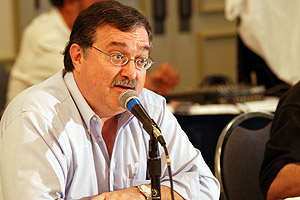
WILFRED MCCLAY, UNIVERSITY OF TENNESSEE AT CHATTANOOGA: I was curious about black unaffiliated and black less-observant. There’s a presumption here that all blacks are observant, and there’s no way to break out that category either.
GREEN: No, there isn’t, and some of the unaffiliated are African Americans. Again, the samples are so small we can’t break out those groups.
But you’re right; there is often an assumption that all African Americans are Protestants and that they’re all highly observant, and of course not all African Americans are.
BARONE: Yes, but you need to go from data to anecdote to find out about that.
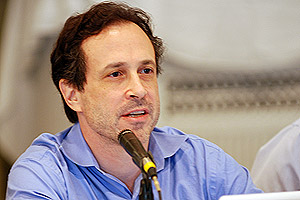
DAVID VAN BIEMA, TIME: What’s the name of the poll that’s coming out in February, and when is it coming out?
GREEN: The name of it is the U.S. Religious Landscape Survey, and it’s scheduled to be released by the Pew Forum in February. I don’t know the exact date.
BARONE: When is the interviewing being conducted?
GREEN: The interviewing has been completed; it was conducted in the spring and summer of 2007.
DIONNE: This is so large I believe you’ll be able to distinguish between atheists and agnostics, no? Or, yes.
GREEN: Yes.
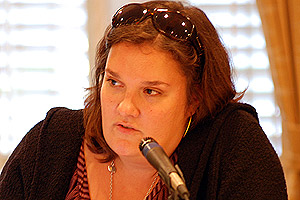
CLAIRE BRINBERG, CNN: I have two-and-a-half questions, which I’ll make tight. One, if you could just quickly restate when and why church attendance became a factor. Also, there has been a whole lot about the evangelical collapse, the end of the religious right, and the disempowerment of the leaders we’ve come to talk to so often. I wanted to get your sense of whether that’s overstated, whether it’s true, and what we can look forward to from the leadership going forward.
Two, I wanted to get your take on all the coverage of the so-called religious left and Democrats’ faith outreach and whether that really can be considered parallel to what’s going on on the Republican side.
GREEN: Let me try to take them in order. Throughout most of the history of polling in the United States, church attendance, which was asked repeatedly back into the 1930s, had no statistically significant impact on the vote. It only began to have an impact in 1972. Since then, it has fluctuated a good bit but has become a staple of American voting behavior, particularly in the 1990s. It’s possible that 2004 will have been a high point; we really don’t know.
What caused church attendance to become relevant? It seems to me that the rise of cultural conflict, engaged regular worship attenders in most, but not all, religious communities, in a very different way than it engaged the less frequent attenders. If one looks at large surveys that have lots of religious measures, you find regular worship attendance is highly correlated with very traditional religious beliefs.
There also may be a social connection, in that people who are at the same place at the same time on a regular basis interact with each other. People have been attending worship services for a long time in the United States, but it became politically relevant when cultural conflict became central to national politics. By this argument, if cultural conflict declines, then we may well see the impact of church attendance on voter behavior decline as well. So this is a relatively recent phenomenon and may not be an inevitable feature of religion and politics.
I tend to think the obituaries being written on the “religious right” may be a bit premature. That’s because I’ve seen a lot of these obituaries written since 1979, and the religious right is still around. Certainly, the organized religious right is going through a period of tension and change, but that’s happened before.
My colleagues and I wrote in 1989 about how the movement was over, only for the movement to get a second wind in the 1990s. I was actually quoted in a textbook saying that some time after the 2000 election, the religious right would begin a slow, steady, fading into oblivion. But I didn’t know about same-sex marriage – (chuckles) – it was revived by that issue.
Yes, these organizations and leaders we’re all familiar with are going through a period of change. The change may be more profound this time because of generational change: the aging of that generation of leaders that brought us the Moral Majority and then the Christian Coalition and Focus on the Family. I do think there are some big changes there. I would prefer E.J.’s formulation over the crackup language we’ve seen in some places in the press. I don’t think this change is abrupt; I think it’s slow and steady.
It also may have to do with a change in the issue agenda. Politics is currently dominated by economic and foreign-policy concerns; there simply may be less for the religious-right leaders to work with in this election. E.J. quoted Nathan Glazer earlier about the evangelical movement being a “defensive offensive,” but to the extent that the movement was a reaction to cultural change, there is always the possibility that cultural change will continue to occur, and therefore, the reaction will continue, perhaps under different leadership or in a different guise.
Prior to 1979 or 1980, with the rise of the Moral Majority, if you were to ask most scholars about the involvement of religion in American politics, they would have told you the bias was toward the left, that the involvement of most religious people in politics was on the liberal side of the political spectrum. One of the great unanswered questions was why religious conservatives were not active in politics. There were great tomes written about why there was something inherent in conservative religiosity or traditional beliefs that precluded these groups from being active in politics.
That turned out to be wrong. When the issue mix was right, and conditions were appropriate, of course we got the religious right we all talk about today. So the religious left has been around in different incarnations for a long time. There has certainly been a bit of, dare I say, a revival of that point of view since the 2004 election. Most of it, however, is among elites, among leaders and activists of various kinds. Most of them are not new.
Jim Wallis is a good example. Jim Wallis has been around for a long time; he may be getting a little more of a hearing now than in the past, but we’re looking at a difference in degree, not a difference in kind. One of the really interesting questions about 2008 is: Will we get an effective religious left that can actually mobilize voters and have an impact at the polls in the way the organized religious right has in the past? The jury is still very much out on that question. But at the elite level, at the level of activists and leaders, there certainly is a lot of foment going on with the religious left and a return to the kind of prominence it had in previous eras.
DIONNE: It seems to me that the importance of the religious left now is that it marks a change from the initial reaction to the religious right. When the religious right rose, a lot of people on the left, including religious people, reacted more against the word “religious” than the word “right.” The first-draft reaction was to say, “This is illegitimate engagement in politics. They can’t quote the Scriptures like that, et cetera, et cetera.”
I think the religious left in this phase is saying, “Wait a minute, there’s nothing wrong with people drawing political conclusions from their religious beliefs, but we draw different conclusions, and we’re going to contest that terrain.” I think that’s a very important, strategic move on the part of people who are religious and progressive.
Secondly, I think you’re seeing in this election that Hillary Clinton and Barack Obama certainly, and to some degree John Edwards, seem to be more comfortable talking about religion in politics than any other Republicans except for Mike Huckabee, and we’ll see how Governor Romney does on Thursday.
Lastly, I think it’s complicated for the religious left or progressives or moderates, center-left, whatever you want to call them, to mobilize in the way the religious right did. What do African-American churches and white evangelical Christian churches have in common? They are relatively homogeneous and both of them – In some ways, the religious right simply copied the success of the African-American church in mobilizing people. A lot of people who might be called religious moderates or progressives belong to very politically diverse churches, so that you don’t mobilize through the church. Indeed, in a lot of these churches, people would be very uncomfortable mobilizing.
A friend of mine who is an Episcopalian in Dallas noted to me that when he looked at the parking lot in his Episcopal church, half the cars that had stickers had Bush stickers and the other half had Kerry stickers. So it’s more complicated, I think, for religious moderates and progressives to mobilize in the same way the Christian right did. I agree with John that the jury is still out on what the meaning of this movement is going to be on Election Day.
BARONE: On 1972 as the emergence of religious right: Part of that may have been an artifact of the fact that white Southerners were pretty much always voting Democratic before 1972. The people we supposed to be religious conservatives in the North were probably voting much more Republican, and that changed in ’72.
The other thing I’d note is the declining saliency of the abortion issue. Do you hear Democratic candidates talking about it at all? I don’t. Do you hear Republican candidates talking about it? Yes, when baby-boomer mainstream media reporters ask them questions about it.
DIONNE: Huckabee talks about it.
BARONE: Huckabee talks about it, but you don’t get a lot of it. I think part of it is we have reached a kind of compromised solution on abortion. We’re not going to criminalize it; the voters of South Dakota last year repealed a criminalization law in a referendum. At the same time it’s been stigmatized. The number of abortions is declining. Medical schools don’t teach it, and people don’t go around bragging that they’ve had abortions.

ADRIAN WOOLDRIDGE, THE ECONOMIST: I wanted to shift the conversation onto foreign policy for a while, partly because there is some polling evidence that suggests the God gap has been replaced by the “bomb gap,” in the sense that the biggest predictor as to whether you’re a Republican or Democrat now is not how often you go to church but your attitude toward national assertiveness. These are not either/or things, and I wanted you to say a bit about why it is that different religious traditions have different attitudes to foreign policy. American exceptionalism, national assertiveness, and the rest of it: How do you map these things?
Secondly, you have this bizarre situation on the right where Bush has linked Wilsonian democratization with Jacksonian national assertiveness. Do you think there’s any sense of that continuing to appeal to the so-called religious right, or are various other currents of opinion such as isolationism going to reassert themselves in the foreign policy mix?
GREEN: It is interesting because, as E.J. pointed out, one of the things that helped George Bush assemble his winning coalition in 2004 was that he had a lot of different groups, and foreign policy was something that worked pretty well for him. Since then foreign policy has become more of a liability for him and also for his party. It may very well be that a lot of the religious communities that supported Bush had very different views on these foreign policy questions, and they could all agree that they preferred Bush to Kerry, but it was an uneasy alliance. I’ll do my best to answer the question, but I hope Michael and E.J. will jump in as well since foreign policy is a little beyond my level of expertise.
White evangelical Protestants are still among the president’s strongest supporters even though their support has declined along with everybody else’s. They are still among the strongest supporters of the war in Iraq. In some surveys that ask questions about foreign policy attitudes, there is some evidence that white evangelicals, particularly the more observant, are the most likely to agree with that synthesis of Jacksonian assertive nationalism and Wilsonian internationalism. When you move beyond white evangelicals, however, that synthesis doesn’t seem to have very many supporters.
White evangelicals, though, are very internationalist, and I don’t see them returning to isolationism anytime soon. I think they’ll be engaged in arguments about what to do with internationalism, but I don’t see any retreat into isolationism whatsoever.
To the extent that there’s isolationism, it’s found among secular Americans, various religious minorities, and less observant Christians. I don’t think there is a full-blown isolationism, but these groups have developed a real skepticism toward the Bush style of aggressive foreign policy.
Of course, the Roman Catholic Church was four square against the war in Iraq. Many Roman Catholics, even in 2004, were opposed to the war in Iraq, but much more supportive, at least at that point, of the war on terrorism and some of the other things Bush was doing internationally. Mainline Protestants are very deeply divided over these questions. There’s a liberal wing of mainline Protestantism that is internationalist but I guess the term of art is they’re “cooperative internationalists:” they’re very supportive of diplomatic efforts and don’t want the use of military force unless it’s absolutely necessary and authorized by international bodies –
CROMARTIE: By France.
DIONNE: Now, now.
GREEN: When John Kerry talked about that in one of the debates in 2004, he talked about how intervention had to rise to a certain global level and that created a big flap. Many mainline Protestants agreed with him on this issue. Other mainline Protestants are more internationalist, not necessarily Wilsonian though. They think American policy ought to follow our interests; it’s maybe a little closer to what is known in international relations as a realist position rather than a Wilsonian position. So, there’s a lot of complexity out there.
The group that is, in my mind, the most interesting is the Jewish community, which is very strongly supportive of Israel and very strongly critical of the Iraq war. American Jews see the world beyond American borders in a much different way than many other religious groups. To the extent that these foreign policy issues – and foreign policy isn’t one issue, it’s a series of issues – come to the fore, they bring out a lot of the divisions between and among these religious groups.
BARONE: I would just make reference to Walter Russell Mead‘s Special Providence and his latest book God and Gold, in which he delineates different strains of American opinion over the years in foreign policy, including the Jacksonians, who basically take the Andrew Jackson line, “If you threaten my family, I’ll kill you,” to what I believe he calls the Jeffersonian impulse, emphasizing the role of missionaries in American foreign policy going back many years: the American University in Beirut, old China hands. These strains work in various ways in various political parties over the years.
I think John is right to stress the complexity in this, as we’re seeing it work out. In the case of the mainline Protestants, for example, on the one hand, you’re supposed to be internationalist and be aware of Le Monde and so forth. At the same time, you’ve got to be very respectful of international institutions. Those tendencies have roots in the different American traditions, but I can’t work that all out here.
DIONNE: I just want to point out, if you look at my name, I am a French Massachusetts liberal – (chuckles).
I want to make two quick points. One, Walter Russell Mead talked about the rise of the Jacksonians. I think what you’re seeing now is the working out of a deep contradiction in the Bush foreign policy because Jacksonians really aren’t Wilsonians; it’s a very different approach. As nicely summarized by Michael, Jacksonians will hit when they are hit, but don’t really want a lot of engagement; Wilsonians have a much more idealistic view, and there’s just a contradiction there. We can poll on this to figure it out. I suspect a lot of white evangelicals are more Jacksonian than they are traditional internationalists.
I think as long as Bush is in power, there will still be enough loyalty to him among a significant body of white evangelicals that they will answer polling questions in a way that’s broadly sympathetic to Bush. I think when Bush is gone, and particularly if the Republicans go out of power, you’re going to see a lot of ferment on the Republican side.
BARONE: But we’ve also seen the interesting phenomenon of Rick Warren, the concern about AIDS, Sam Brownback, and from evangelicals with the Jeffersonian or missionary tradition; they’re following through on that, interestingly.
DIONNE: By the way, the person who should answer this question is John’s 25-year-old son, a foreign policy genius and a realist, by the way.
The other thing is, there is – and I am very sympathetic to this – a Niebuhr revival going on, and I think that’s going to continue. It’s realism married to morality, humility about American power combined with a willingness to use it when necessary, and I suspect there’s going to be a lot said and written about, “What would Niebuhr do?” in the next five years. My book is very much part of that tradition.
PARKER: I don’t have any stats to back this up, but anecdotally speaking, and not to contradict the Jacksonian theorists, but it seems to me if there is a white evangelical Protestant support for the Bush foreign policy agenda, it probably has something to do with the fact that their kids are over there fighting.
I don’t know what the numbers are, but I know the Southeast empties out when wars start, and these people are not so much loyal to his policy as they are loyal to their children and would consider it disloyal to contradict the president.
DIONNE: Unfortunately, military service is not shared widely enough, I think, for that to explain it all. It’s true there are a lot of Southerners in the military. There are also quite a few Catholics and a lot of African Americans. It’s not a broad enough group in terms of shared sacrifice, but it’s a diverse group of people fighting for the country.
BARONE: I believe more children of members of Congress have fought in Iraq than fought in Vietnam, even though we had a purportedly egalitarian draft in the Vietnam period, and we have a –
DIONNE: Is that true?
BARONE: Yes, I believe so. Both Democrats and Republicans have had kids serving. I’ve found, in my own circle of friends, people like Michael Ledeen: his daughter served in civilian capacity in Iraq –
DIONNE: But he’s not a member of Congress.
BARONE: No, but I’m saying in this group of people I know – and two sons are in the Marine Corps.
DIONNE: This is a data question because Mark Shields called every member of Congress and found only one member of Congress who had a person in the enlisted ranks and a couple who had somebody in the –
BARONE: No, I think it’s about 10 that have served at one time or another over there, and that’s more than Vietnam.
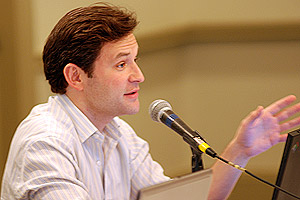
DAN HARRIS, ABC NEWS: On this issue of evangelical attitudes toward Mormonism: Who was it at breakfast this morning who said they spoke to Albert Mohler, head of the Southern Baptist seminary, and he is supporting Romney? But I believe the Southern Baptists still, on their website, have Mormonism under the “cult” category. Is this ability to do those mental gymnastics just among elites, or – Why are their followers not following them on that in significant numbers?
The other question for you is about global warming. I know in years past, you and I have talked about green evangelicals. Is that intensifying as we get these now four, hair-on-fire alarming reports from the U.N. about how bad the situation is and could become?
GREEN: Let me answer the second question first. I don’t see any evidence in surveys, as of this moment, that attitudes on global warming among evangelicals have changed very much.
It could be that the impact of those reports has not been felt yet because it takes time for these things to reach the public. But, as you and I discussed, if one looks at support for very broad measures on environmental protection, a majority of evangelicals agree with protecting the environment – less so than the population as a whole, but there is certainly a lot of support for that point of view. When you get into specific questions of climate change, the numbers are lower among white evangelicals than for the population as a whole, but it’s not as if evangelicals aren’t interested in that idea. But I don’t see any major statistical change yet. We may see that in the future as the polls come along.
The issue of evangelical attitudes towards Mormons is interesting. It certainly is the case that the elites – the clergy and the group leaders – are much more nimble when it comes to these things. A good example is Bob Jones III’s endorsement of Romney. He is not a Southern Baptist, but he’s head of the Bob Jones University. The endorsement was lukewarm. On the one hand he said, “Mormons are not Christians, that’s where I stand.” On the other hand, he said, “We’re not electing theologian-in-chief, we’re electing a chief executive, and I think Governor Romney has the right values.” That surprised a lot of people because if there was any element of the evangelical community that was going to stand against Mormonism, one would think it would be the card-carrying fundamentalists.
The problem Southern Baptist elites have with this nimbleness – and some of them do want to support Romney or might want to support Romney – is their denomination has spent a lot of time pointing out to their followers that Mormons are not Christians. As you may know, there’s rather intense competition between the Latter-day Saints and the Southern Baptists and other evangelicals over proselytizing, with their missionaries running into each other in the United States and around the world. These groups very much compete for saving souls.
I have heard, and you would want to run this down rather than quote me, that the leaders of the Baptist Convention are thinking about revising their view of Mormonism to no longer classify it as a cult, but to classify it as another form of Christianity, which is a view that a lot of sociologists and historians would adopt, but maybe not a view theologians would necessarily accept. In any event, if the collective leadership of the Southern Baptists all decided they wanted to back Romney, they would have the problem of translating that to their followers, having been so critical of Mormons for so many years.
CROMARTIE: With Pat Robertson’s endorsement of Rudy and now Al Mohler’s endorsement of Romney, the story that needs to be written here is about evangelicals as pragmatists, that people really are bracketing theological and doctrinal differences for political reasons.
DIONNE: Or, the story could be, if Huckabee continues to be strong, that these leaders don’t have the pull that they claim to have, or what we think they have. Just looking at page two of the now un-embargoed Pew survey, I found it fascinating. Look at the Iowa numbers. Thirty-eight percent of the Republican caucus electorate, they are projecting, is evangelical. Of that, Huckabee gets 40%; Romney 21%. In the rest of the electorate -62% – it breaks 28-15 Romney over Huckabee. I think one of the questions we will ask is how much Mormonism has to do with that. I suspect that will be heavily polled in the coming period: How much of it is really positive for Huckabee?
But the other interesting thing is, for Huckabee in South Carolina, where he is much less well-known, 53%, as somebody pointed out, of that electorate is evangelical. Of that, he’s only got 12%. What’s intriguing is if Huckabee were to do well enough in Iowa to move on, does this become an issue in South Carolina, and does Huckabee come up in the polls there? In New Hampshire – it’s so striking – only 18% of that electorate is white evangelical, suggesting that is a state Rudy Giuliani is targeting for good reason.
BARONE: These numbers on Huckabee in Iowa remind me somewhat of Jesse Jackson in ’84 and ’88, and leads to the possibility that white evangelicals in this contest may end up – It’s possible they may end up not unanimously but heavily favoring a candidate who basically can’t be nominated. I think that’s one possible scenario, in which they take themselves out of the equation of determining who the real nominee is. Black voters in ’88 didn’t do anything to determine the Democratic nominee.
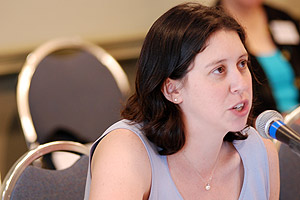
NAOMI SCHAEFER RILEY, THE WALL STREET JOURNAL: I wanted to ask about the question of Rudy’s electability on this survey here. He just seems to dominate the electability category, and I was trying to figure out from what you were saying how pragmatic you expect religious voters to be and whether there are any historic comparisons here.
BARONE: Democratic voters in ’04 were the ones concerned about electability. As Mickey Kaus, the blogger and friend of many of us, said, the Iowa Democrats just made a stupid choice about determining who was electable. What this survey tends to confirm, I think, is that Republican voters this year are concerned about electability and with good reason. One of the arguments we’re hearing both the Democratic and Republican candidates making can be heard as electability arguments. Hillary says Obama has no foreign policy experience. Translation: He’s going to get clobbered on this in the general, so don’t vote for him. And Obama’s saying Hillary polarizes people. Translation: Fifty percent are going to vote against her no matter what. Those are electability arguments.

JACQUI SALMON, THE WASHINGTON POST: Having talked to a lot of evangelical leaders lately about Mormonism, I can say a lot of them are really struggling with this issue of, “We can’t stand his religion but he’s so strong on social issues.” It’s clear a lot of them are going to be splitting on that.
A question about Latino evangelicals: Where are they when it comes to non-Catholics? The evangelical Latino leaders are energetically saying they’re going to be a real swing vote in this election because of their stand on social issues. John, tell me about where you feel they stand.
GREEN: As E.J. pointed out, Latino Protestants – the vast majority of which are evangelicals – supported Bush in 2004 with a majority. The polls differ on how big the majority was, but that’s because this is a group that’s hard to measure in surveys. It’s a small group but a rapidly growing group, and there are a number of reasons why this community has liked the Republicans. Part of it is because of social issues, which are very important to them; part of it is because Latino Protestants are more likely to be assimilated or to be on the road to assimilation into American society.
So there are a number of different reasons why Latino Protestants might like the Republicans, but the potential deal-breaker is immigration and immigration reform. In some of the polls we’ve looked at recently, Latino Protestants are not as enthusiastic about the Republican candidates. In that sense, George W. Bush understood something about that constituency that maybe some of his fellow Republicans didn’t understand.
That’s the big problem for Republicans going into 2008 with Latino Protestants and Latinos in general: How do they get over the immigration issue? If the polls I’ve seen are accurate -and it’s hard to know because, again, these groups are so small in most surveys – then Republicans are in a big bunch of trouble on that particular issue.
The key thing is, though, to what extent Western states are in play politically because a lot of the Latino population is located in the West. There is some evidence that the Mountain states -Colorado, Arizona, New Mexico -may be in play in 2008. If one assumes Latino Catholics will still be largely Democratic, as in 2004, then Latino Protestants could provide an opportunity for the Republicans.
DIONNE: In ’06, I can’t remember if it was a swing of 11-12-13% away from the Republicans. Bush pushed the Latino vote up to something like 40% for him, and it was, as I recall, down to the low 20s in ’06 because of immigration. I think that’s only aggravated now, and some very prominent conservative evangelical Latino leaders were very upset, and are still very upset, by what happened on immigration. I think that’s a very important piece of this.
The other is the diversity of the Latino vote. California Latinos, mostly Mexican, are much more Democratic than Latinos elsewhere because there’s still a backlash from Prop-187 all those years ago. Texas Latinos are Democrats, but less so than California Latinos. Here in Florida, it’s a very complicated community because of the Cuban vote, which has been historically Republican. It was drifting Democratic until Elian Gonzalez came along, and the gains that Clinton made were then pushed back among Cubans. I think on immigration there is some division but mostly just anger at the way this issue has played out. Then, there is this enormous regional, ethnic and religious diversity within the community.
BARONE: I agree with all that both John and E.J. have said. To underline the diversity of the Latino vote, go to Pico Union in Los Angeles, and it’s about 90% Democratic. If you go out to Santa Ana, which is in Orange County and is 78% Latino or something, they are voting about 55% Democratic; they are less than an hour apart on Interstate 405.

MIKE ALLEN, THE POLITICO: John, I was hoping to get your view of E.J.’s observation about George Bush as an apex for the evangelical vote, and I’m wondering what the mix was of passion for Bush and the mechanical mobilization of evangelical voters by Bush-Cheney.
GREEN: I think it was both. President Bush had, and still has, a special relationship with the white evangelical community. We were just talking a moment ago about the lack of influence some leaders in the evangelical community have on their followers. A good example of this pattern was in the 2000 election, when a lot of leaders of the Christian right were supporting candidates other than George W. Bush, and he basically appealed to the rank-and-file voters over the objections of the leaders, because of the way he could talk about his faith. Once in office and after 9/11 and into 2004, that relationship was solidified. I think it would be difficult to replicate that relationship with another Republican candidate.
ALLEN: You mentioned the way he talked about his faith. How else did that personal relationship develop?
GREEN: I mostly observed it in terms of polling numbers, so I don’t know all of the details of it. But part of it was the way he talked about his faith; that was extremely important to the evangelical community. Some observers argued that Bush used special code in some of his speeches to appeal to evangelicals. I don’t think there was anything special about it, but he used a lot of evangelical language in many of his most prominent speeches.
In addition, Bush made some promises, and he kept them. He promised to sign a late-term abortion measure if the Congress passed it. The Congress passed it; he signed it. He promised to appoint conservative judges, particularly to the Supreme Court; he did. Coming full circle, the Supreme Court, now with the Bush appointees on it, accepted the late-term abortion bill as being constitutional.
When I look at the exit polls or other survey data on 2004, I find it very difficult to disentangle the personal regard for Bush from the mobilization effort of his campaign. They’re so closely linked together.
DIONNE: Amen to that. It’s also worth remembering that this President Bush was the previous President Bush’s informal or maybe even formal liaison to the evangelical community in his father’s campaigns, and he learned a lot, and he created a lot of ties, and I think that all came back to help him later.
BARONE: In effect he’s a convert from mainline Protestantism to evangelical Protestantism, and everybody knows that because they know his family, and the father is such an obviously mainline type, and the mother, too. So the bio becomes very vivid for people.
MCCLAY: John, I noticed we haven’t talked about gender, and you don’t have data disaggregating by gender. I wondered, given Hillary Clinton’s candidacy this particular election, whether that wouldn’t be worthwhile. I have a suspicion you do have some data that disaggregates by gender; if you do, I’d like to hear some of it. There’s this notorious statement of Mark Penn‘s that 24% of Republican women will vote for Hillary Clinton, which, of course, is more than wishful thinking.
But it does underline an interesting question that relates to religion in general: The behavior of men and women who fall into similar categories is still going to be rather different. As one can see looking at church attendance – In certain categories, particularly mainline and African-African churches, the predominant congregant is going to be female and maybe less so in white evangelical churches, although that would depend on the kind of evangelicalism in the region. But I wonder if there’s any data that disaggregates by gender with the faith factor taken into account that you could share with us.
GREEN: There certainly is, and that’s a very insightful question. A lot of demographic factors matter at once. Religion, at least at the level we typically measure it, is best thought of as a demographic factor: the groups that people belong to and how active they are in those groups. Gender certainly has a very powerful independent effect on politics. Almost all, perhaps all, of the religious groups we have been looking at contain gender gaps, in which men tend to be more Republican, and women tend to be more Democratic. In very strongly Republican groups, like weekly attending white evangelicals, of course, everybody is, on balance, Republican, but women are less so. And when you get into even the unaffiliated community, men are more Republican than women.
Of course, the situation is quite complicated because it’s not just gender; it’s also family status and age. Older married women with children are still more Democratic than their male counterparts, but they are more Republican than their female counterparts who are younger and unmarried. So gender is actually quite a complex thing, and it intersects with religion in a complicated way.
There is a lot of polling that shows Senator Clinton does have an appeal to women across the board. She seems to have the most appeal among younger women and women who are Democrats. But it’s possible she would be able to do better than another Democratic candidate among women in some of these conservative religious communities. But for women in some of these conservative religious communities, there’s a countervailing tendency, which is they don’t agree with Senator Clinton on many issues. They may like the idea of woman president, but not necessarily this woman as president.
MCCLAY: Looking at a category like weekly attending white evangelical Protestants: It’s not untypical for the weekly attending portion of a married couple to be the wife who takes the children to Sunday school. But is the man in that dyad counted as a weekly attending white evangelical Protestant, even if he only shows up once in a while – Christmas, Easter, a few other times?
GREEN: The way we measure, no, because it’s an individual-level measure. The guys that stay home and get ready for the NFL while their wives take the kids off to church would be in the less-observant category.
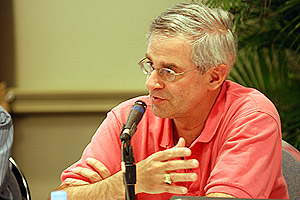
DAVID SHRIBMAN, PITTSBURGH POST-GAZETTE: All three of you are suggesting there’s some movement among white evangelicals, and that the data isn’t broad enough, the universe isn’t big enough, to know this specifically, but how would you speculate on the breakdown? Who is in motion, and who is staying, and who is going? What is prompting them to go and stay?
GREEN: Boy, that’s a really good question. It’s a large religious community, but in these types of surveys, of course, it’s very difficult to break out their various characteristics. We’re not supposed to speculate at the Pew Forum, but I will indulge you for the moment.
Here’s what I think the data shows. I would say a lot of it has to do with religious beliefs and religious behaviors, that the people who are least in motion are the most traditional in their beliefs and behaviors. Those that are most in motion are those who are more moderate or centrist.
SHRIBMAN: Does that mean people who have considered themselves white evangelicals the longest, perhaps?
GREEN: It could be the longest; there are age effects as well. But I think the effect of belief and behavior is somewhat independent of age. As E.J. was pointing out, the centrist and the modernist evangelicals are probably the most likely to be moving. Generation has a tremendous effect. Young evangelicals are – as young people often are – less stable in their political alignments. In your packets, there is something you may have seen on the Pew Forum website looking at the political proclivities of young evangelicals in recent years. They seem to be in motion.
Another factor is income and class status. Lower-income evangelicals are more likely to be in motion. Evangelicals who are well-off are less likely to be in motion and more likely to stick with the Republicans because of their class status.
DIONNE: Amen to all of that. The young evangelicals are very much in motion. They are as pro-life or anti-abortion as their elders, but they are somewhat more liberal on issues related to gays and lesbians.
SHRIBMAN: There’s no recollection of Reagan. Or more importantly, of Carter.
DIONNE: Right, and their whole generation is significantly more Democratic than everybody older than they are. So there are some signs of motion. I don’t have data on this, but I am fascinated; I hope somebody produces it. I think people in suburban megachurches outside the South are probably different from other kinds of evangelicals, that there is a kind of moderate suburban ethos. Bob Wuthnow has written about this. One of my favorite Wuthnow findings is that 58% of Americans agreed that Christianity is the best way to understand God, but only 25% said it was best for everybody. Our friend David Brooks discovered from a rabbi the wonderful phrase, “flexidoxy.” Many Americans, including I think a lot of folks in the megachurches, are flexidox; they yearn for orthodoxy but want it to be flexible on something they care about. I have a suspicion that – again, when we’re talking about movement, we’re not talking about a massive movement to the Democratic Party; we’re talking about a minority of this group that’s in flux – suburban churchgoers outside the South may be one of the groups that is in flux.
BARONE: My speculation would start off with young rather than the old. As you pointed out last night, David, the median-age voter in 2008 is born in 1966; they were never in a gas line in the 1970s; they were never paying weekly bills when effective tax rates were going up, and there was hyperinflation on bills in the 1970s. They never had those experiences. They only read about it in the paper, except they don’t read the papers either.
I think E.J.’s point about flexidoxy or Christianity may not be for everybody. I would suspect part of that is an awareness that there are Jews in this country, and that it’s a respect for the Judeo-Christian religion. It’s possible that evangelical Protestants, on some dimensions, are more pro-Israel than Reform Jews these days. I think it’s a tip to that. The attitudes on things like same-sex marriage or gay issues: That’s hugely different by age groups among all segments of the population, as I understand it. So people over 65 just have the same attitude as all of America in the 1950s – that it’s unthinkable. Whereas under 30s are about 50-50 on same-sex marriage.
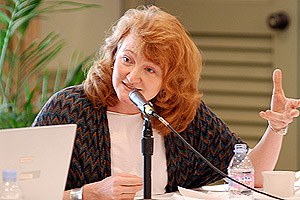
KRISTA TIPPETT, SPEAKING OF FAITH: I’m looking at Table 7. I’m especially interested in the broadened agenda of evangelicals and the younger generations. I’m wondering if you have comparable statistics, showing a breakdown of what people say they care about? I’m thinking the 2004 exit polls asked the question in a different way.
GREEN: They did.
TIPPETT: So do you have any comparable statistics from a couple of years ago? Do you have anything that breaks it down by generations?
My other question is, when we talk about evangelical Protestants, are you counting evangelical Episcopalians? Are you counting evangelicals who are not in evangelical churches?
GREEN: In these measures, yes. Because in these surveys, the way the evangelical category is measured is born-again Protestants.
TIPPETT: (Inaudible, off mike.)
GREEN: That’s right. You do get a little bit different results if you can break out denominational affiliations. Episcopalians as a group are a mainline Protestant body, but some people who attend those churches consider themselves evangelicals. So you do get a difference if you could define evangelicals that way. But the differences are not huge. One of the reasons the pollsters use the born-again measure is that it’s very powerful.
TIPPETT: I just think that many people, when they see “evangelical Protestants,” don’t think: Episcopalians, Presbyterians, Lutherans, although some are included in there.
My second question is related to that. In terms of proportion, I’ve heard everything from 25 to 40% of the American population is evangelical. What’s the discrepancy there? I think you come out at about 25%, right?
But does that 40% count – Are Pentecostals included in that? I know the National Association of Evangelicals includes Pentecostals in its numbers. Do you include Pentecostals? Does that 40% number include a much broader base of evangelicals?
GREEN: The evangelical community, as you all know, is a very complicated thing. It’s complicated by its nature because of the intense religious individualism of evangelicals. Most scholars would argue the evangelical religious tradition is made up of a number of different groups. Pentecostals would be one group. The largest single group of evangelicals is the various kinds of Baptists. There are many non-denominational churches within the evangelical tradition, many associated with religious movements like fundamentalism or the neo-evangelical movement.
There are many denominations within the major Protestant families that are self-consciously evangelical. A good example is within the Presbyterian family: The Presbyterian Church in America is a self-consciously evangelical church as opposed to the Presbyterian Church (U.S.A.), which is a self-consciously mainline Protestant denomination.
So we have a very complicated religious community, and how do we arrive at one figure? We do it by defining what we mean by evangelicals depending on our purpose. I tend to use a religious-affiliation definition because I’m interested in politics, and the groups people belong to are important politically. The best measures of affiliation in survey after survey tend to produce this estimate of about 25% of the American population. Now, it is not everyone in that 25% is a white evangelical because, as Adelle was pointing out, there are black evangelicals, and Hispanic, and Asian evangelicals. If one were interested in theology or sociology, one might want a different definition.
TIPPETT: Are charismatic Roman Catholics or neo-Pentecostal African Americans included? Is that where the number gets bigger than 25%?
GREEN: Yes, exactly. You can arrive at a bigger number if you include the historically black Protestant churches, and if you were to reach outside of Protestantism and include charismatic Roman Catholics. Most analysts don’t do that because there are still important differences between Catholics and Protestants. But you could count these groups as evangelical if you were interested in the beliefs and practices these groups have in common. As you were pointing out, there are many people in mainline Protestant denominations that think of themselves as evangelicals.
The more general you make the definition, the larger the number becomes. Forty percent is not an unreasonably number if you include all these different groups that meet one or another criteria for being evangelical. But you can go the other way as well. The pollster George Barna, himself an evangelical, likes to define evangelicals in a very narrow, doctrinal way. He has seven specific doctrinal statements that one has to agree to to be considered an evangelical. He comes up with an estimate of about 6 or 7% of the American population being evangelicals.
TIPPETT: Really?
GREEN: Yes, because he’s got such a strict doctrinal definition. So the simple answer to your question is, what do you mean by evangelical? Do you mean a set of religious communities? And how broadly do you define those communities? One can reasonably range from 7 to 8% to 40 to 45% depending on what pieces of the puzzle you are interested in picking up. I’m a political scientist, and the Pew Forum is interested in public affairs, so my bias is toward group membership in defining evangelicals. But certainly these other ways of defining evangelicals are valid as well.
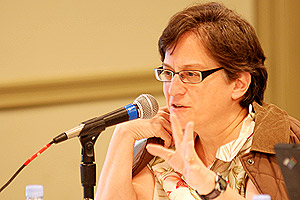
ANDREA STONE, USA TODAY: Since Michael mentioned Israel and evangelicals, I just want to make a point. When you said evangelicals are more pro-Israel than many Reform Jews, what is the meaning of “pro-Israel?” It will be very interesting to see in the next year, as this Annapolis process starts, if we will see a divergence between evangelicals and the Bush administration’s efforts – presuming the Bush administration really makes an effort – and the support that Reform Jews or all Jews really – well, not all Jews, not Orthodox Jews – will give to that process.
But my question has to do with gays. Even though it’s premature to write the obit on the religious right, we’re going to do that anyways. It just seems like we’re moving in that direction, and that we are hearing more from the religious left on issues like the environment, the economy, AIDS and healthcare and this and that. I’m wondering what that means for gay issues because every single Democratic candidate has said they oppose don’t ask, don’t tell. They don’t really want to go near gay marriage yet, but there’s more support for civil unions. I’m wondering what we’re going to see from the religious community in terms of political support for any advances on gay rights.
BARONE: You’re asking me to define pro-Israel and, as I understand it, there’s considerable disagreement on that term among people who are citizens of Israel – (chuckles) – and I’m not sure I want to wander into that thicket. Evangelicals are probably more Likud and Reform Jews are more Labor, to put it in Israel party-politics terms, or at least in old Israel party-politics terms.
STONE: I ran into more evangelical Christians in Gaza in August of 2005 than I did Reform Jews, so – (chuckles).
BARONE: That’s interesting. I think we understand where we stand on that.
As far as the gay-rights issues, supporting civil unions is now a majority position in the United States in most polls. I’m fascinated to see the Democrats are against the exclusion of gays from the military, which of course was passed by President Clinton and a Democratic Congress. My judgment on the trend of opinions on gay-rights issues has been consistently wrong and erring in both directions, so I’ll just end right there. (Laughter.)
DIONNE: Humility is a great virtue, rarely exercised, especially in settings like this.
I think what Michael said about civil unions is very important: Civil unions is the new middle-of-the-road position. When you think about that, it’s a huge shift in 10 years. Again, attitudes toward gays and lesbians are so age-dependent. You have two key variables to predict how somebody is going to stand on gay-rights issues: age and either having a close friend who is gay or a relative who is gay. Given that more and more people have gay friends, there is an arc that moves, I think, in general in the direction of gay rights.
Marriage will be one of those issues that will take a long time to resolve. As this works through the system, I think you’ll have states moving toward civil unions, and it will come up in the more “liberal” states quicker. But I think it’s a less toxic issue today than it was even a few years ago. It doesn’t mean there won’t be some resonance, but I don’t think it has anything like the resonance it had in ’04.
STONE: Last year I wrote about adoption and foster families among gays. We think about the military and marriage and civil unions, but is there anything over the horizon we’re not thinking of that’s going to be the next big issue?
DIONNE: Immigration. I think immigration is potentially –
STONE: Gay immigration? (Chuckles.)
DIONNE: – a huge wedge issue, and you’re already seeing it play out if you watched the Republican debate last week. Immigration is a very volatile social issue that could create very complicated divisions. I know Democrats like Rahm Emanuel are very worried about it in certain Congressional districts from the Democratic point of view.
STONE: Is that a gay issue, though? That’s what I was asking.
DIONNE: No, no, no. I was talking more generally of wedge issues.
STONE: No, I was asking, is there some other issue having to do with gays that we’re not thinking of that’s going to pop up?
BARONE: The conservative writer Bruce Bawer lives in Norway because his partner is a citizen of Norway, and he doesn’t have a basis to get a visa to live in the United States. He would like to be married and have his spouse come over on a visa available to spouses.
GREEN: I don’t know if this answers your question directly, Andrea, but I think one of the places to watch this issue evolve is within the major denominations, where there are big arguments about ordaining gay clergy and whether clergy can bless unions. A lot of the activism is within these denominations. That’s really something to watch because how that turns out will have a big effect on how these different religious communities will view this issue in the future.
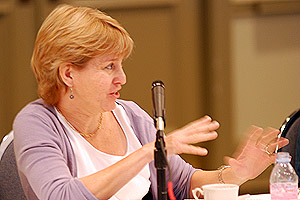
LINDA FELDMANN, THE CHRISTIAN SCIENCE MONITOR: I was wondering if you have any polling data on voter knowledge as it relates to Rudy Giuliani. I’m interested in an explanation for the support that he does have. It goes to this pragmatism versus ignorance question; as voters become more knowledgeable about his positions, are evangelicals moving away from, or are they taking the pragmatic position and sticking with him?
GREEN: We did ask that question in some Pew Forum and Pew Research Center surveys. On the one hand, we found a very large proportion had no idea what Rudy Giuliani’s position was on abortion. So the ignorance factor may be playing a big role here. On the other hand, among those people who could correctly identify his position, it didn’t seem to make any difference. So maybe there’s a pragmatic element there as well.
DIONNE:RealClearPolitics has nice charts on this. There are two ways of looking at Giuliani. On the one hand, it’s striking that he has maintained his national lead all year. On the other hand, he was up in the 40s or high 30s at the beginning of the year, and there’s been a slightly downward slope, but not so downward that he’s fallen behind anybody yet. I don’t know if that reflects more knowledge of him or more knowledge of other candidates.
BARONE: I think part of what’s going on with Giuliani is the focus of voters on cultural issues has changed. The press tends to see abortion as the central issue. If you’re a 58-year-old feminist, it probably is and has been for a long time. I think for 28-year-olds, it’s not the most important issue anymore.
Giuliani has this unique characteristic: We have actually seen him operate in a crisis, and we know that he can stand up in a crisis. That’s a powerful thing that trumps the cultural issues for some voters. The change in standing I’ve seen on Giuliani is that he’s seen as a much more partisan figure now. He was getting 67% favorable ratings early in the cycle, and now he’s down to about 54. Basically, Democrats have identified him as an enemy more than cultural conservatives have.
DIONNE: He’s also one of the best-known human beings in the United States, and that’s not to be discounted when we’re looking at polls.
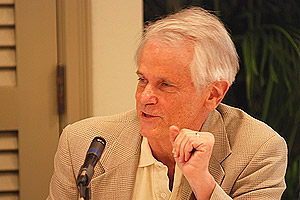
SHELBY COFFEY, THE NEWSEUM: A question partly based on E.J.’s thought that maybe we are entering into a breathing spell in some of the cultural wars. I want to put forth a counter-hypothesis: It may be a change, but arguably, we might be in for more culture wars because a number of factors amp up the national dialogue. You see more interest groups viewing with alarm each issue as the media is digitized. In order to get noticed, the louder voices, on whatever platform, get louder. Artists constantly look for the shock value. If you are shocked by this one year, you are going to be even more shocked the next year. It takes that.
Given that, could you speculate as to what issues might be emerging more? Michael was touching on that, about how the issue of abortion is now less prominent, but are issues used up faster now, especially in the context of the religion and values conflicts we were discussing?
DIONNE: Part of my premise is so much of this polarization is related to President Bush. I think he’s a uniquely polarizing figure not only because of the hostility he has aroused on the left side of the spectrum, but also because of the loyalty he aroused on his own side; Bush is a unique figure who combines within himself the two key wings of the Republican party.
He’s evangelical, and he’s a big-business or, if you prefer, country-club Republican. He’s all of those things at the same time. For a long time he has inspired a lot of loyalty and a lot of dislike. One of the big unanswerable questions is: Does the polarization diminish when Bush is out of office? My hunch is it does and that something different happens afterward. If Mrs. Clinton is elected, do we reproduce a different kind of polarization? I don’t know, but maybe we do.
Secondly, I do think some of the social issues are being diffused, and I agree with Michael on abortion, but I’d put it slightly differently. There was a bill introduced in Congress that is currently part of the budget; it’s got a long, complicated name, but it’s basically an abortion-reduction act. A whole group of pro-life and pro-choice Democrats sponsored a bill that said, basically, “Abortion is not going to be illegal anytime soon. Many of us in this group don’t think that it should be illegal. But abortion is, at best, a moral problem. For some in the group, it’s a moral evil. So what can we do to reduce it?” There are a whole series of measures both on the contraception side and to help poor women who want to bring their kids into the world. The abortion rate is four times higher among poor women than among better-off women.
That’s a very interesting movement in the party. Rudy Giuliani has been bragging about the reduction in the abortion rate in New York City. On the cultural and religious issues, there may be depolarization, but as I said before, I do think if we’re on the lookout for polarizing cultural issues of a different sort, at the moment, immigration is the one. To me, the evidence is mounting that that’s going to be a very divisive issue.
GREEN: One of the interesting things about the immigration issue is that many people who oppose immigration do so on cultural grounds; they see the immigrants as disruptive. There is another group of people that opposes immigration on economic grounds because it takes jobs. But the cultural argument is very prominent.
Let me just suggest two other areas of cultural antagonism that may emerge in the near term. One is the whole question of religious expression, such as the phrase, “One nation under God” in the Pledge of Allegiance. This is an ongoing controversy about what appropriate religious expression is in public life, and it flares up from time to time. That’s an issue that might very well antagonize people.
The other thing to watch is public education, which is regular battleground. One thing to watch in that area is the push toward vouchers, which now has a certain constitutional status. There are a lot of groups – some of them religious, some of them non-religious – that would like to see us move away from public schools toward vouchers.
DIONNE: The fascinating thing about vouchers is a lot of suburban parents are against vouchers because they like the public system they’re in, and they don’t want to spend any tax money –
BARONE: And the Republican legislators that represent them are happy to take teacher-union money and avoid teacher-union-financed opposition.
I think the immigration issue is one. I think there is an interesting coalition from both parties that is talking about immigration and assimilation. I think, ultimately, it behooves politicians and particularly Republicans, but generally Democrats as well, to say, “We really do have to regularize this stuff and get the law working in tandem with the labor market.” I think we’re going to go to a national identification card, and we’re some distance toward that with the Real ID Act. Also, we have to help people become Americans. You’re not hurting people by helping them learn English; you’re helping them. We’re not being punitive when we do that. I think that’s very important.
Just one footnote on what John Green was saying about religious expression: My pet peeve this time of year is that when you go Christmas shopping, the stores only play secular songs now. I’m going to storm out if I have to hear “The Most Wonderful Time of the Year” played over and over and over again at Nordstrom. I think I’m going to go to the manager and ask for “God Rest Ye Merry Gentlemen.” (Laughter.)
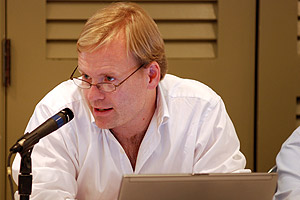
JOHN DICKERSON, SLATE: In the churn in the data we’re seeing and in this playing field where a lot of things are moving around, what do we know in the data or anecdotally about people dropping out altogether? There’s the great myth or truth that Karl Rove talks about in the 2000 race, the famous four million evangelicals who didn’t play. Where are they now? Some people dispute that that’s a real fact.
The second question is about the map. Are we going to be talking about the same 12 states in ’08 that we’ve been talking about over the years, or does this churn suggest new places are in play? If no new places are in play, are there particular states in which – obviously it depends on the candidates – in which this new landscape has particular impact?
GREEN: I’ll defer on the religious landscape to Michael and E.J. Certainly Ohio will be on the list, but other than that, I don’t know. I think there is great capacity for demobilization in certain religious groups. When leaders of the Christian right say the Republicans should not nominate Rudy Giuliani because in a contest between Giuliani and Clinton, there will be a decline in turn-out, I think they may be on to something. The question is, just how big would the demobilization be? One can imagine it being quite large, particular where it would make a difference in key swing states. A lot depends on the effort made to get these voters to turn out.
I can imagine many evangelical voters I’ve interviewed over the years being very discouraged by a Giuliani-Clinton race because abortion is really important to them, and they couldn’t make a choice between those two candidates on that basis. But if they got enough direct mail and enough people knocked on their doors, they might be able to make a choice based on other matters. The choice might be based on an entirely different set of issues than their past choices. So, I think the capacity for demobilization is very real. I just don’t know how large it would be.
BARONE: The ’04 election really contributed something; it’s always been pious political conventional wisdom that if we were just nicer, more people would participate. We were real nasty in ’04 cycle and participation went way up. The Democratic vote went up from 48 to 59 million, the Republican vote from 48 million to 62 million. There’s lots of millions of people. Some of them may indeed drop out or not vote next time. Some of the people mobilized as Republicans in ’04 voted Democratic in ’06. But in general, ’06 turn-out in the states was significantly higher than ’02, which was pretty good for an off-year turn out. I think we’ve increased the size of the electorate.
Which states are in play? At this point, I’d say about 40. (Laughter.) What’s unusual between ’00 and ’04 – and you can put ’96 in with it if you just look at the Democratic percentage – is how static they are. Go back in history: It’s unusual. They haven’t had something quite like that since ’52 and ’56. That’s 50 years. Compare ’88 and ’96 and tell me how many states are in play. The answer is about 35 to 40 between those two elections that were only eight years apart. If I were polling for the candidates, I might skip Rhode Island and Vermont and Alaska, but I would be doing most of the states, at least a little bit.
DIONNE: I agree with John on demobilization. I think the party that’s most discouraged gets demobilized. In ’06, there was some discouragement of Republicans; we’ll see if that lasts. On the question of states, I think a bunch of new states are in play: Colorado; Nevada; New Mexico; Arizona, for sure, with the combination of Latinos and political change; maybe Montana; Arkansas; certainly Virginia; and maybe not this cycle, but someday, North Carolina. I would say potentially vulnerable Democratic states, if it gets closer, might be Minnesota, Iowa, Wisconsin, and New Hampshire. Iowa did go Republican the last time. The one state I think Rudy Giuliani might put in play is New Jersey. I don’t think it’s New York; I don’t think it’s Pennsylvania. New Jersey could go in.
BARONE:Quinnipiac had Giuliani even in Connecticut with Hillary last month when he was losing nationally.
CROMARTIE: Say that again, Mike?
BARONE: Quinnipiac had Rudy even with Hillary, one point down, I think, in Connecticut, which was a 10-point carry state, 54-44. So I’d put Connecticut in there.
DIONNE: Italian Americans are not to be ignored as a significant voting block in some states.
BARONE: Those three are the most Italian states, plus Rhode Island.
CROMARTIE: Ladies and gentlemen, you can tell a good session – and all of ours have been this way – when we have to end because we have gone into overtime. Let me not forget to say this event could not happen without the help of Cheryl Montgomery and Robbie Mills and their good work in getting everybody here. (Applause.)
Join me in thanking our speakers this morning. (Applause.) Thank you for coming.
This written transcript has been edited for clarity, spelling, grammar and accuracy and by Andrea Useem.
* Please note the following corrections to the written transcript:
The numbers in the tables were checked and corrected based on Michael Barone’s comment. The correct numbers are as follows. Table 2: Among the weekly attending other Christians polled, 53.3% preferred a generic Republican candidate. Table 3: Among weekly attending other Christians polled, 50.3% preferred Giuliani over Clinton. These corrections are reflected in the tables included with this transcript.






